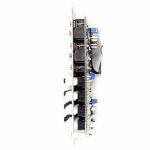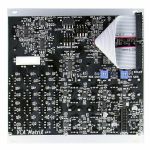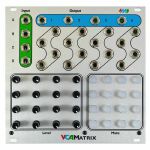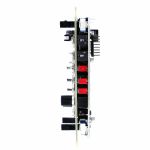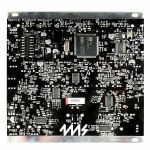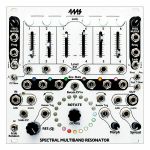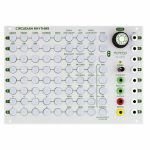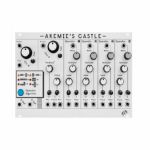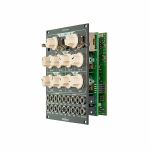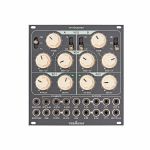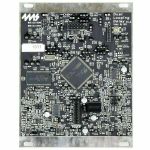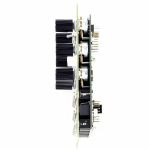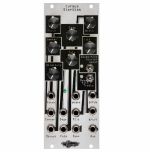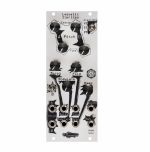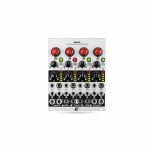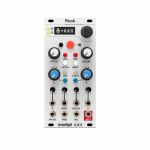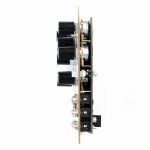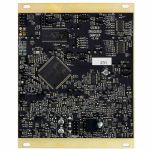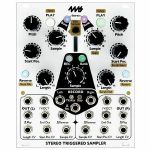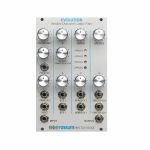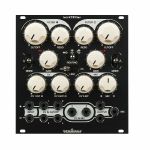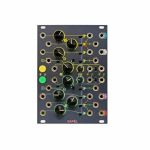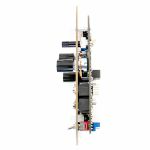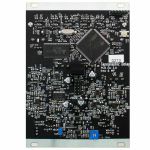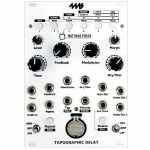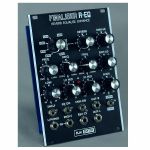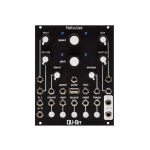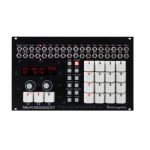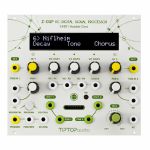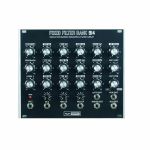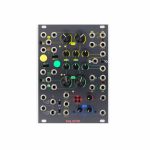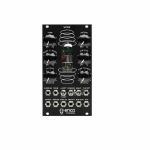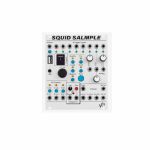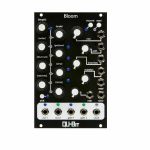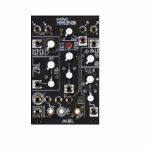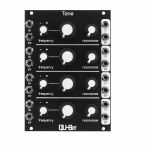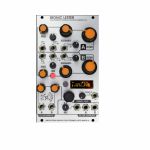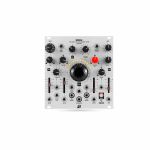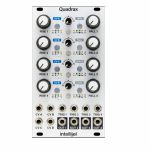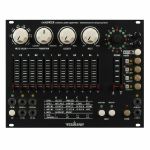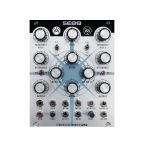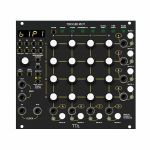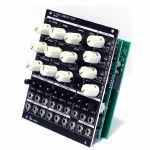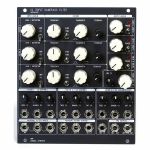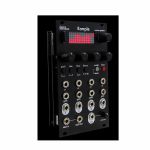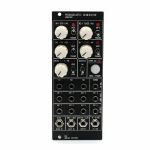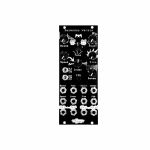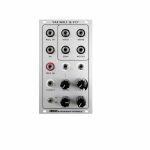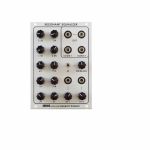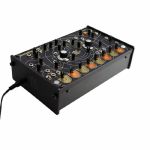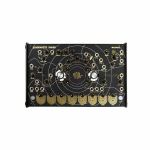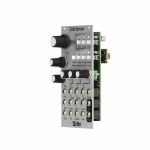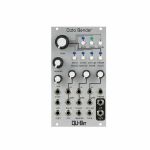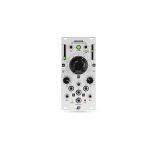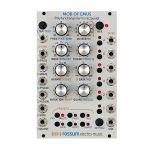安全购物
Studio equipment
Our full range of studio equipment from all the leading equipment and software brands. Guaranteed fast delivery and low prices.
安全购物
DJ equipment
Our full range of DJ equipment from all the leading equipment and software brands. Guaranteed fast delivery and low prices. Visit Juno DJ
Filter
Stock
Coming Soon
Equipment
Format
Release Date
Brand
Featured
Price
Tags
WMD PDO MKII Phase Displacement Oscillator Module (LFO/oscillator synth module)
Cat: 580280 Rel: 29 Jul 15
Phase Displacement Oscillator (PDO) synth module with analog sawcore VCO - 16HP wide
Notes: The MKII version of the PDO is available: Better CV handling, 16 HP, single PCB instead of stacked boards. An upgrade path is available for those with MKI versions, contact us for more information.
Introducing the WMD Phase Displacement Oscillator (PDO). This hybrid VCO has all the feel of an analog VCO but with the benefits of digital waveshaping. The PDO will easily find a home in your system!
The PDO exists to utilize the phenomenon of Phase Modulation (PM). This allows for the relative phase difference of its outputs to be set or modulated, producing very interesting sounds. The result is similar to Frequency Modulation (FM) but affects the output to a greater degree without affecting the stability of the initial frequency. This is where the "displacement" comes in.
When you use frequency stable phase displacement, you create phase distortion which sounds like wavefolding and is very useful for dynamic textures and powerful sounds.
PM has the same benefits of quadrature filters/sine wave generators and greatly exceeds their capabilities at audio rate modulations. PM is highly useful for for creating metallic and bell tones and very controlled harmonic interactions.
Because PM affects the relative phase and not the frequency of the waveform generated, the PDO can self modulate its PM inputs. This creates complex harmonic signals that seem to vary in frequency but are quite stable.
Phase Modulation is also quite powerful when using the PDO as an LFO. Adjusting the relative phase of each output allows for very precise modulation of other modules. Each output can have any of the available waveforms simultaneously. There is a myriad of modulation possible with the PDO!
… Read moreIntroducing the WMD Phase Displacement Oscillator (PDO). This hybrid VCO has all the feel of an analog VCO but with the benefits of digital waveshaping. The PDO will easily find a home in your system!
The PDO exists to utilize the phenomenon of Phase Modulation (PM). This allows for the relative phase difference of its outputs to be set or modulated, producing very interesting sounds. The result is similar to Frequency Modulation (FM) but affects the output to a greater degree without affecting the stability of the initial frequency. This is where the "displacement" comes in.
When you use frequency stable phase displacement, you create phase distortion which sounds like wavefolding and is very useful for dynamic textures and powerful sounds.
PM has the same benefits of quadrature filters/sine wave generators and greatly exceeds their capabilities at audio rate modulations. PM is highly useful for for creating metallic and bell tones and very controlled harmonic interactions.
Because PM affects the relative phase and not the frequency of the waveform generated, the PDO can self modulate its PM inputs. This creates complex harmonic signals that seem to vary in frequency but are quite stable.
Phase Modulation is also quite powerful when using the PDO as an LFO. Adjusting the relative phase of each output allows for very precise modulation of other modules. Each output can have any of the available waveforms simultaneously. There is a myriad of modulation possible with the PDO!
1 in stock $400.15
Click for better price!
or call +44 20 7424 1960
quote 580280
quote 580280
4ms VCA Matrix 4-Input & 4-Output VCA Module With 16 Routing Options (mixer VCA synth module)
Cat: 589496 Rel: 10 Dec 15
Playable 4x4 matrix synth module of 16 VCAs - 26HP wide
Notes: The VCA Matrix from 4ms is a playable 4x4 matrix of 16 VCAs.
Four CV or audio inputs can be routed in any amount/combination to four outputs, using the 16 CV control jacks, Level knobs, and Mute buttons.
… Read moreFour CV or audio inputs can be routed in any amount/combination to four outputs, using the 16 CV control jacks, Level knobs, and Mute buttons.
2 in stock $340.33
Click for better price!
or call +44 20 7424 1960
quote 589496
quote 589496
4ms Spectral Multiband Resonator Module (filter/envelope follower/digital/oscillator/dual/stereo synth module)
Cat: 589505 Rel: 10 Dec 15
Innovative resonant filter synthesiser module - 26HP
Notes: The Spectral Multiband Resonator from 4ms Company is an innovative resonant filter which can process audio like a classic filter bank, ring like a marimba when plucked/struck, vocode, re-mix tracks, harmonize, output spectral data, quantize audio to scales, and much more...
A gorgeous ring of colored lights displays the frequency of each filter, as well as the levels and current scale selection(s).
At a glance, the SMR works like a normal six-band graphic EQ: six frequency band-pass filters are mixed together using sliders. Resonance/Q is variable, which changes the "ringy-ness" or width of the bands.
But here's where comparison stops. The frequency of each channel is treated like a note in a scale, and the six bands form a chord. Spin the Rotate knob and the "notes" circle around the scale, rotating back to the bottom once they've reached the top. Adjust Spread and the distance (interval) between each note changes. Triggers for up/down motion, CV inputs for sequencing and scale selection allow for flexible control with external modules. Morph, which automatically cross-fades between frequencies, together with variable Slew allows rhythmic clocks drive the SMR as a variable-speed evolving resonant filter.
At maximum Resonance/Q, the SMR can be struck like a gong or marimba by inputting clocks or triggers. The frequency of each channel is quantized to a scale: beautiful chords, ethereal tones and eerie ambiance flows easily. With lower resonance, the SMR can pull out particular frequency bands, and sweep these across the spectrum.
Two 1V/octave Frequency jacks allow for tracking even and/or odd bands and creating floating melodies over evolving chord bases, or complex percussive membrane sounds.
Save your settings into one of six storage banks, and recall on the fly. On startup, the SMR instantly jumps to the last saved settings. The color scheme of the lights can be adjusted, so if you prefer all white lights on your modular, you can have that (or all red, or rainbows, pastels, etc..)!
Advanced features:
- Program your own scale. The frequency of each of the 20 notes can be assigned by setting the octave, the semi-tone, and coarse and fine micro-tone. Up to 11 scales can be saved permanently in the user bank
- Adjust color scheme of the LEDs. Pick a pre-programmed color scheme or create your own using the sliders to set Red/Green/Blue values. Custom color schemes can be saved permanently
- Save your settings in one of six parameter banks. Note position, scale and bank selection, Q value, Lock settings and color scheme can be saved and recalled on the fly. On startup, the SMR loads settings from the last saved bank.
- Optional alternative filter type for a more exponential decay when plucked and different timbral qualities. Freq jacks no longer track 1V/oct in this mode.
- Slider LEDs can be assigned to display level for each channel (combination of slider position and CV on the jack), or clipping for each channel.
… Read moreA gorgeous ring of colored lights displays the frequency of each filter, as well as the levels and current scale selection(s).
At a glance, the SMR works like a normal six-band graphic EQ: six frequency band-pass filters are mixed together using sliders. Resonance/Q is variable, which changes the "ringy-ness" or width of the bands.
But here's where comparison stops. The frequency of each channel is treated like a note in a scale, and the six bands form a chord. Spin the Rotate knob and the "notes" circle around the scale, rotating back to the bottom once they've reached the top. Adjust Spread and the distance (interval) between each note changes. Triggers for up/down motion, CV inputs for sequencing and scale selection allow for flexible control with external modules. Morph, which automatically cross-fades between frequencies, together with variable Slew allows rhythmic clocks drive the SMR as a variable-speed evolving resonant filter.
At maximum Resonance/Q, the SMR can be struck like a gong or marimba by inputting clocks or triggers. The frequency of each channel is quantized to a scale: beautiful chords, ethereal tones and eerie ambiance flows easily. With lower resonance, the SMR can pull out particular frequency bands, and sweep these across the spectrum.
Two 1V/octave Frequency jacks allow for tracking even and/or odd bands and creating floating melodies over evolving chord bases, or complex percussive membrane sounds.
Save your settings into one of six storage banks, and recall on the fly. On startup, the SMR instantly jumps to the last saved settings. The color scheme of the lights can be adjusted, so if you prefer all white lights on your modular, you can have that (or all red, or rainbows, pastels, etc..)!
Advanced features:
- Program your own scale. The frequency of each of the 20 notes can be assigned by setting the octave, the semi-tone, and coarse and fine micro-tone. Up to 11 scales can be saved permanently in the user bank
- Adjust color scheme of the LEDs. Pick a pre-programmed color scheme or create your own using the sliders to set Red/Green/Blue values. Custom color schemes can be saved permanently
- Save your settings in one of six parameter banks. Note position, scale and bank selection, Q value, Lock settings and color scheme can be saved and recalled on the fly. On startup, the SMR loads settings from the last saved bank.
- Optional alternative filter type for a more exponential decay when plucked and different timbral qualities. Freq jacks no longer track 1V/oct in this mode.
- Slider LEDs can be assigned to display level for each channel (combination of slider position and CV on the jack), or clipping for each channel.
1 in stock $426.96
Click for better price!
or call +44 20 7424 1960
quote 589505
quote 589505
Tiptop Audio Circadian Rhythms Step Sequencer Module (white) (clock generator/sequencer/random module)
Cat: 590414 Rel: 05 Apr 16
Step sequencer module - 36HP
Notes: The Circadian Rhythms is moving modular synthesizer technology another step forward by gluing all the pieces of a system together. Each module or voice can now be programmed to play straight from an intelligent, eight-channel, 512-step master trigger sequencer made for composers looking to make music on the modular. Building on the sequencing concept of step programing multi-channel patterns of musical phrases can be repeated, looped, chained, muted and manipulated on the fly in real-time, and most importantly, all of this is done through a simple, clearly labeled interface. Using an array of multicolor illuminated buttons and innovative grid views provides a highly functional live performance sequencer with a beautiful glowing appearance of the programmed music that will look amazing on stage for both performer and crowd. As a master controller, the heart of the modular synthesizer, Circadian Rhythms generates high precision clock and reset signals for all the other sequencers and devices in the system to align with and can also act as a high precision bridge for DAW synchronization.
Views - Unlike most hardware sequencers that have a single static display of a timeline, Circadian Rhythms offers four different horizontal views of the timeline and two unique vertical views that scale from macro to micro. Switch between viewing 64 steps at once or all 8 channels side by side instantly. Stretch gates over multiple patterns to drive envelopes or use Zoom view to move a single hit back a few milliseconds in time to get the right feel all from the same interface.
LED Grid Built for Quick Access - Built around 72 buttons set as a multi-color illuminated 8x9 array, Circadian Rhythms displays both note data and settings in a clear and precise manner. It takes only one click to switch to vertical view and the grid turns into a set of programming and realtime playing functions like Mutes, Loops, Swing, Fills, Copy and Pate, Grouping, Randomizing, Manual trigger entry drum machine style and many many more. Activate any of those functions with only a button press or two.
Clock - Inside the CR ticks an extremely precise clock with jitter and latency measured in mere microseconds for the ultimate feel of groove. The four modes of clock sync make interfacing with other modules, hardware or software simple. Whether driving a large Eurorack system or synced to a DAW, the groove always remains tight.
SyncBus Technology - The Tiptop Audio designed SyncBus enables the CR to connect to any number of other SyncBus devices with the highest possible level of synchronization. A SyncBus master directly injects its core clock and running status into every connected unit so they work seamlessly as one device. Hook up two CRs to make a 16 channel device or add a Trigger Riot (or three) to the mix for further experimentation. Plus, the connection is done behind the panel so no need to patch anything together.
Under The Hood - When state of the art chip technology, musically driven firmware, and professionally engineered hardware design all come together in one electronic device, the result is a music sequencer with unparalleled specifications. Starting with a powerful, precise sequencing engine that has superb feel for the groove, add internal functions that automatically balance performance and smooth user interface operation, and finish with outstanding low power consumption placing minimal stress on power supplies even at maximum output, Circadian Rhythms has a design focused on the requirements of the most dedicated musicians and composers. Long time pros will immediately feel a machine made for their needs, while the newcomers can instantly dive into next level programming and performance.
… Read moreViews - Unlike most hardware sequencers that have a single static display of a timeline, Circadian Rhythms offers four different horizontal views of the timeline and two unique vertical views that scale from macro to micro. Switch between viewing 64 steps at once or all 8 channels side by side instantly. Stretch gates over multiple patterns to drive envelopes or use Zoom view to move a single hit back a few milliseconds in time to get the right feel all from the same interface.
LED Grid Built for Quick Access - Built around 72 buttons set as a multi-color illuminated 8x9 array, Circadian Rhythms displays both note data and settings in a clear and precise manner. It takes only one click to switch to vertical view and the grid turns into a set of programming and realtime playing functions like Mutes, Loops, Swing, Fills, Copy and Pate, Grouping, Randomizing, Manual trigger entry drum machine style and many many more. Activate any of those functions with only a button press or two.
Clock - Inside the CR ticks an extremely precise clock with jitter and latency measured in mere microseconds for the ultimate feel of groove. The four modes of clock sync make interfacing with other modules, hardware or software simple. Whether driving a large Eurorack system or synced to a DAW, the groove always remains tight.
SyncBus Technology - The Tiptop Audio designed SyncBus enables the CR to connect to any number of other SyncBus devices with the highest possible level of synchronization. A SyncBus master directly injects its core clock and running status into every connected unit so they work seamlessly as one device. Hook up two CRs to make a 16 channel device or add a Trigger Riot (or three) to the mix for further experimentation. Plus, the connection is done behind the panel so no need to patch anything together.
Under The Hood - When state of the art chip technology, musically driven firmware, and professionally engineered hardware design all come together in one electronic device, the result is a music sequencer with unparalleled specifications. Starting with a powerful, precise sequencing engine that has superb feel for the groove, add internal functions that automatically balance performance and smooth user interface operation, and finish with outstanding low power consumption placing minimal stress on power supplies even at maximum output, Circadian Rhythms has a design focused on the requirements of the most dedicated musicians and composers. Long time pros will immediately feel a machine made for their needs, while the newcomers can instantly dive into next level programming and performance.
2 in stock $445.52
Click for better price!
or call +44 20 7424 1960
quote 590414
quote 590414
ALM Akemie's Castle Dual 4 Operator FM VCO Module (oscillator synth module)
Cat: 584261 Rel: 15 Apr 16
Dual voltage controlled oscillator (VCO) synthesiser module with authentic 4 operator digital FM - 38HP wide
Notes: 'Akemie's Castle' is a dual voltage controlled oscillator with authentic 4 Operator digital FM using 'new-old-stock' Yamaha IC's for audio signal generation.
Each of the 4 operators feature independent waveform selection, frequency multiplier and level control via direct panel operation and voltage control. Operators can be combined in various ways across both oscillators, which together with independent feedback control on each VCO, offer an extremely wide palette of sounds.
Oscillator A also features a chord mode providing a range of up to 5 voice chords and voltage controlled inversion.
… Read moreEach of the 4 operators feature independent waveform selection, frequency multiplier and level control via direct panel operation and voltage control. Operators can be combined in various ways across both oscillators, which together with independent feedback control on each VCO, offer an extremely wide palette of sounds.
Oscillator A also features a chord mode providing a range of up to 5 voice chords and voltage controlled inversion.
2 in stock $478.53
Vermona twinCussion+ Dual Percussion Voice Module (drum/dual/stereo/envelope generator/noise/oscillator synth module)
Cat: 624960 Rel: 08 Sep 16
A duophonic percussion/drum module which offers you two individual, almost identical voices.
Notes: A duophonic percussion/drum module which offers you two individual, almost identical voices. Each of them has an oscillator with selectable waveforms as well as an attack-decay envelope which simultaneously can modulate the pitch and the VCA.
A large number of sockets is available which not only are used for modulating and triggering the drums but also emit any oscillator waveform and envelopes. That is utterly useful!
The first difference between both voices are the available waveforms: voice A offers square, triangle and sine, while voice B has noise, square and sine. For atonal noisy sounds like hi hats and anything cymbal voice B is more suitable.
The wave forms are switch selectable and simultaneosuly available at individual outputs i.e. you can process the audio signals exernally. Using the module's EG CV outputs plus two external VCAs you can re-create or alter the signal flow. Envelope signals and audio sources are available!
For controlling the frequency there's a hi/lo switch alternating between bass and treble, then a tune control and a modulation attenuator which scales either the envelope or a nexternal CV. besides individual inputs (A VCO and B VCO) there's also a common CV input VCO A+B which addresses both voices simultaneosuly. A VCO is normalized to the VC CV input A VCA, analogical for channel B.
The second difference is in the envelopes. Voice A has an attack-decay envelope generator with manually adjustable times. Voice B has a decay envelope with fixes attack time but with voltage control of decay time via EG 2 input and the CV EG2 attenuator.
The envelope generators are able to modulate not only the pitch but simultaneously also the level. For that reason there's an second attenuator which altternately detemines the intensity of an external CV (see above).
Each voice has an individual audio output, although OUT B works as a mix output when no cable is plugged to OUT A.
*essentially two things have changed in the + version:
-the output levels of the MIX outputs have been increased
-the frequency of the filter for noise can now also be controlled via CV
Power consumption: 105mA at +12 V and 70mA at -12 V
Depth: 45mm
HP : 24
… Read moreA large number of sockets is available which not only are used for modulating and triggering the drums but also emit any oscillator waveform and envelopes. That is utterly useful!
The first difference between both voices are the available waveforms: voice A offers square, triangle and sine, while voice B has noise, square and sine. For atonal noisy sounds like hi hats and anything cymbal voice B is more suitable.
The wave forms are switch selectable and simultaneosuly available at individual outputs i.e. you can process the audio signals exernally. Using the module's EG CV outputs plus two external VCAs you can re-create or alter the signal flow. Envelope signals and audio sources are available!
For controlling the frequency there's a hi/lo switch alternating between bass and treble, then a tune control and a modulation attenuator which scales either the envelope or a nexternal CV. besides individual inputs (A VCO and B VCO) there's also a common CV input VCO A+B which addresses both voices simultaneosuly. A VCO is normalized to the VC CV input A VCA, analogical for channel B.
The second difference is in the envelopes. Voice A has an attack-decay envelope generator with manually adjustable times. Voice B has a decay envelope with fixes attack time but with voltage control of decay time via EG 2 input and the CV EG2 attenuator.
The envelope generators are able to modulate not only the pitch but simultaneously also the level. For that reason there's an second attenuator which altternately detemines the intensity of an external CV (see above).
Each voice has an individual audio output, although OUT B works as a mix output when no cable is plugged to OUT A.
*essentially two things have changed in the + version:
-the output levels of the MIX outputs have been increased
-the frequency of the filter for noise can now also be controlled via CV
Power consumption: 105mA at +12 V and 70mA at -12 V
Depth: 45mm
HP : 24
1 in stock $327.95
4ms DLD Dual Looping Delay Module (delay/dual/stereo/effect synth module)
Cat: 589504 Rel: 02 Nov 16
Advanced audio processor synthesiser module for creative synthesis - 20HP wide
Notes: Announcing the Dual Looping Delay from 4ms Company, designed by Gary Hall!
The 4ms Dual Looping Delay (or DLD) is an advanced audio processor for creative synthesis. Not a tape or analog emulation but a modern crystal-clear digital delay, the DLD combines features of delay, looping, and sample-tight synchronization for powerful and dynamic sound capture and modification. The DLD is designed to integrate seamlessly with modular time-base and sequencing devices such as the 4ms Quad Clock Distributor (QCD), etc.
What is a "Looping Delay"?
Modern looping devices grew directly from hardware digital delays of the late 70s and early 80s. A looping delay, modelled on units such as the classic Lexicon PCM42, has the very long storage times associated with dedicated looping, but without triggered record and playback functions.
By default, a looping delay records and plays continuously, though recording can be suspended at any time with Infinite Repeat. Sustain of delays and loops is mainly accomplished with regeneration, allowing an organic, evolving approach to sound creation as new material replaces old, more or less gradually. The 4ms Dual Looping Delay also provides advanced clock input and output facilities that allow for locking delayed and looped material with sequencers and rhythm devices of all descriptions.
The 4ms Dual Looping Delay is conceived and designed by Gary Hall. Implemented and manufactured by 4ms Company
… Read moreThe 4ms Dual Looping Delay (or DLD) is an advanced audio processor for creative synthesis. Not a tape or analog emulation but a modern crystal-clear digital delay, the DLD combines features of delay, looping, and sample-tight synchronization for powerful and dynamic sound capture and modification. The DLD is designed to integrate seamlessly with modular time-base and sequencing devices such as the 4ms Quad Clock Distributor (QCD), etc.
What is a "Looping Delay"?
Modern looping devices grew directly from hardware digital delays of the late 70s and early 80s. A looping delay, modelled on units such as the classic Lexicon PCM42, has the very long storage times associated with dedicated looping, but without triggered record and playback functions.
By default, a looping delay records and plays continuously, though recording can be suspended at any time with Infinite Repeat. Sustain of delays and loops is mainly accomplished with regeneration, allowing an organic, evolving approach to sound creation as new material replaces old, more or less gradually. The 4ms Dual Looping Delay also provides advanced clock input and output facilities that allow for locking delayed and looped material with sequencers and rhythm devices of all descriptions.
The 4ms Dual Looping Delay is conceived and designed by Gary Hall. Implemented and manufactured by 4ms Company
1 in stock $390.87
Click for better price!
or call +44 20 7424 1960
quote 589504
quote 589504
Noise Engineering Cursus Iteritas Dynamically Generated Wavetable Oscillator Module (silver faceplate) (synth module)
Cat: 641952 Rel: 28 Feb 17
Dynamically generated wavetable oscillator using multiple orthogonal functions
Notes: Cursus Iteritas is an oscillator that works from a dynamically generated wavetable. It gives the user spectral-like controls over three different modes based on different conceptualizations of frequency: Fourier, which uses sine waves; Daubechies, using wavelets, and Walsh mode, using the Walsh transform. Cursus Iteritas parametrizes a wide variety of sounds, but because the sounds are all based on orthogonal functions, it has a musical tone structure and can produce an extremely wide variety of harmonic sounds.
Size: 10HP Eurorack
Depth: 1.5 Inches
Power: 2x8 Eurorack
Draw +12V: 150 / 80
Draw -12: 5 / 5
Draw +5v: 0 / 90
… Read moreSize: 10HP Eurorack
Depth: 1.5 Inches
Power: 2x8 Eurorack
Draw +12V: 150 / 80
Draw -12: 5 / 5
Draw +5v: 0 / 90
1 in stock $328.99
Noise Engineering Loquelic Iteritas Rev 2 Multiple Algorithm Digital Oscillator Module (silver) (digital/oscillator synth module)
Cat: 641954 Rel: 28 Feb 17
Comb oscillator, VOSIM, summation synthesis & phase modulation with adjustible waveform & wave folder
Notes: Loquelic Iteritas is a digital VCO with interpretations of three classic synthesis algorithms involving dual pitch control. It creates a huge variety of sounds parameterized by four tone and two pitch controls.
It has had glowing reviews from Surgeon and Surachai, and I am personally very excited about this module!
It has a simple interface, with 3 different synthesis algorithms allied to a number of different controls / CV inputs which have different effects, depending on which mode you choose. Simply hook up a number of modulation sources to the 4 inputs and start wiggling!
Rev.2 now features an additional sync input.
Size: 10HP Eurorack
Depth: 1.5 Inches
Power: 2x8 Eurorack
Draw +12V: 150 / 80
Draw -12: 5 / 5
Draw +5v: 0 / 90
… Read moreIt has had glowing reviews from Surgeon and Surachai, and I am personally very excited about this module!
It has a simple interface, with 3 different synthesis algorithms allied to a number of different controls / CV inputs which have different effects, depending on which mode you choose. Simply hook up a number of modulation sources to the 4 inputs and start wiggling!
Rev.2 now features an additional sync input.
Size: 10HP Eurorack
Depth: 1.5 Inches
Power: 2x8 Eurorack
Draw +12V: 150 / 80
Draw -12: 5 / 5
Draw +5v: 0 / 90
1 in stock $324.86
Xaoc Devices Praga 1967 Voltage Controlled Mixing Console Module (silver) (mixer/panning/VCA/dual/stereo/quad synth module)
Cat: 655355 Rel: 29 Jun 17
Voltage controlled four channel stereo mixer module
Notes: The module is built around high quality VCA chips from THAT Corp, as well as low noise opamps. It offers clickless muting and equal loudness panning. The distinct feature is that voltage control is dynamically compressed should it yield clipping when pushed too hard. Also, in both modes the attenuators offer full closing of the corresponding channel, regardless of being controlled by the CV, or not. The VCAs fully open (0dB gain) at CV=8V in Env mode and CV=5V in LFO mode. All the input and output signal levels are Eurorack levels.
Multiple Praga units can be chained thanks to dedicated headers on the back. The mixed stereo sum of each unit in the chain is added to the mixing bus of all units downstream.
A dedicated Hrad expander will offer master volume control, gate inputs for channels muting/unmuting, headphone amplifier, and voltage control over aux sends.
… Read moreMultiple Praga units can be chained thanks to dedicated headers on the back. The mixed stereo sum of each unit in the chain is added to the mixing bus of all units downstream.
A dedicated Hrad expander will offer master volume control, gate inputs for channels muting/unmuting, headphone amplifier, and voltage control over aux sends.
2 in stock $410.46
Intellijel/Applied Acoustics Systems Plonk Physical Modeling Percussion Synthesiser Module (silver) (digital/oscillator/noise/drum synth module)
Cat: 643387 Rel: 21 Aug 17
Physical modelling percussion synthesiser module - 12HP
Notes: Killer physical modelling module collab from two of the biggest names in their respective fields of hardware and software. Generates a huge range of percussion instruments plus synths and bass tones.
Supplier's notes:
Plonk uses a technique known as physical modelling to synthesize, with great realism, the way in which sound is produced by acoustic instruments. The Plonk module is, itself, focused primarily on creating percussive sounds - both pitched and un-pitched; natural and unnatural; acoustic-sounding or totally electronic.
Plonk does this by breaking sound creation into two distinct elements - the exciter and the resonator. The exciter is a mathematical model of the device used to strike a particular surface. Plonk, because it's percussion oriented, has two types of exciters: one modelled on a mallet, and the other providing a noise source. The resonator is a virtualization of the object being struck, which vibrates, resonates and creates the body of a sound. Plonk offers several types of resonators: beam; marimba; drumhead; membrane; plate; and string.
Plonk provides numerous parameters that let you shape, mould and design both the exciter and the resonator, thus enabling you to synthesize the sound of striking or scraping almost any type of object - real or imagined. In this way, Plonk can accurately model the sounds of kicks, snares, toms, cymbals, claps, tablas, congas and all manner of traditional percussion instruments. It can also model pitched percussive instruments, like vibes, marimbas, and even bass or guitar-like tones. Of course, it additionally excels at modelling instruments that heretofore never existed.
Best of all, the sounds created by Plonk are not static - any sound you design can respond dynamically to velocity, as well as four different modulation inputs. This means the sound of Plonk can change completely from note-to-note (or strike-to-strike). Because of this, Plonk is actually a duophonic (2-voice) module, which lets the sound of one note decay naturally when a second note (possibly employing an entirely different set of modelling values) is struck. Thus, hitting a new note does not choke the sound of the previously struck note (unless you want it to, of course)!
Plonk stores up to 128 patches in its internal memory, and ships with many presets programmed by professional sound designers and composers. You may overwrite these patches if you wish, and banks of patches may be transferred via MIDI System Exclusive over Plonk's built-in mini-USB port to facilitate offline storage by programs or websites that support this capability.
Plonk was developed in cooperation with Montreal-based Applied Acoustics Systems - physical modelling pioneers, and the creators of Tassman, Lounge Lizard, String Studio, Ultra Analog, Chromaphone and numerous other plugins. It is with great pleasure that Intellijel brings the potential of this physical modelling technology to a hands-on, CV-laden device capable of the sort of dynamic control and sonic exploration that modular synthesists demand.
… Read moreSupplier's notes:
Plonk uses a technique known as physical modelling to synthesize, with great realism, the way in which sound is produced by acoustic instruments. The Plonk module is, itself, focused primarily on creating percussive sounds - both pitched and un-pitched; natural and unnatural; acoustic-sounding or totally electronic.
Plonk does this by breaking sound creation into two distinct elements - the exciter and the resonator. The exciter is a mathematical model of the device used to strike a particular surface. Plonk, because it's percussion oriented, has two types of exciters: one modelled on a mallet, and the other providing a noise source. The resonator is a virtualization of the object being struck, which vibrates, resonates and creates the body of a sound. Plonk offers several types of resonators: beam; marimba; drumhead; membrane; plate; and string.
Plonk provides numerous parameters that let you shape, mould and design both the exciter and the resonator, thus enabling you to synthesize the sound of striking or scraping almost any type of object - real or imagined. In this way, Plonk can accurately model the sounds of kicks, snares, toms, cymbals, claps, tablas, congas and all manner of traditional percussion instruments. It can also model pitched percussive instruments, like vibes, marimbas, and even bass or guitar-like tones. Of course, it additionally excels at modelling instruments that heretofore never existed.
Best of all, the sounds created by Plonk are not static - any sound you design can respond dynamically to velocity, as well as four different modulation inputs. This means the sound of Plonk can change completely from note-to-note (or strike-to-strike). Because of this, Plonk is actually a duophonic (2-voice) module, which lets the sound of one note decay naturally when a second note (possibly employing an entirely different set of modelling values) is struck. Thus, hitting a new note does not choke the sound of the previously struck note (unless you want it to, of course)!
Plonk stores up to 128 patches in its internal memory, and ships with many presets programmed by professional sound designers and composers. You may overwrite these patches if you wish, and banks of patches may be transferred via MIDI System Exclusive over Plonk's built-in mini-USB port to facilitate offline storage by programs or websites that support this capability.
Plonk was developed in cooperation with Montreal-based Applied Acoustics Systems - physical modelling pioneers, and the creators of Tassman, Lounge Lizard, String Studio, Ultra Analog, Chromaphone and numerous other plugins. It is with great pleasure that Intellijel brings the potential of this physical modelling technology to a hands-on, CV-laden device capable of the sort of dynamic control and sonic exploration that modular synthesists demand.
2 in stock $305.46
4ms Stereo Triggered Sampler Recorder & Playback Module (sampling/digital/dual/stereo/oscillator/synth voice synth module)
Cat: 655465 Rel: 29 Aug 17
High fidelity, two-channel stereo sample recorder & playback module
Notes: The Stereo Triggered Sampler can record high quality stereo files, while simultaneously playing two different stereo files. A maximum of 600 samples can be loaded from the removable/swappable microSD card, in a variety of formats up to 96kHz/32-bit/stereo WAV. All sample parameters (1V/oct pitch, sample file selection, length, and start position) are CV controllable.
600 Samples:
A maximum of 600 samples can be loaded at once, arranged into banks of 10 samples each. Samples and banks can be re-arranged on the fly using the simple on-board Edit features. Newly recorded samples can be instantly played back and re-pitched, reversed, chopped up, etc... the result of which can even be bounced down and re-recorded to as a new sample! Sample files are limited to 4GB each, which is over 6 hours at 44k/16b/stereo.
Two Stereo Playback Channels:
Each playback channel has a knob and CV jack for Sample File selection, as well as a Start Position knob and CV jack for controlling where in the sample playback will begin. The Length knob and CV jack determine how much of the sample is played back: from tiny grains, to percussive hits, to longer loops... or just the entire file. These are powerful tools for re-arranging a sample, joining multiple samples, and creating dynamically re-sized loops within a larger sample. Combined with the Play Trigger jack and the 1V/oct jack, the STS can be two complete multi-timbral pitch-tracked stereo voices!
There's also a Reverse button and jack for backwards playback, and an End Out jack for synchronizing loops, or cascading sample playback with other events.
Looping and Sync:
Looping is easy: just hold the PLAY button down for two seconds to toggle loop or one-shot. The loop timing clock will output from the End Out jack. Or, send a clock into the Play Trig jack to sync the loop to external timing.
Stereo Recording:
Whether you patched 47 modules to create the ultimate percussive blast, or you want to capture your four hour ambient performance, recording high-quality .wav files on the STS is simple. Just hit the REC button or fire a trigger and a new stereo .wav file will be created on the SD card. Do as many takes as you need: the STS never deletes your files. Re-ordering or re-arranging samples into banks is easy, even without a computer.
You can even fill a bank with 10 different variations and immediately use them for playback.
By default the STS records at 44.1kHz/16-bit, with an option for 24-bit (a future update may increase the sample rate to 96kHz)
Easy sample loading:
Using a computer is completely optional with the STS, since samples can be recorded directly to the module and placed into the bank of your choosing. But for users with large existing sample banks, the intuitive automatic bank loading features make dragging and dropping your entire sample library a snap. You never have to rename your files again!
… Read more600 Samples:
A maximum of 600 samples can be loaded at once, arranged into banks of 10 samples each. Samples and banks can be re-arranged on the fly using the simple on-board Edit features. Newly recorded samples can be instantly played back and re-pitched, reversed, chopped up, etc... the result of which can even be bounced down and re-recorded to as a new sample! Sample files are limited to 4GB each, which is over 6 hours at 44k/16b/stereo.
Two Stereo Playback Channels:
Each playback channel has a knob and CV jack for Sample File selection, as well as a Start Position knob and CV jack for controlling where in the sample playback will begin. The Length knob and CV jack determine how much of the sample is played back: from tiny grains, to percussive hits, to longer loops... or just the entire file. These are powerful tools for re-arranging a sample, joining multiple samples, and creating dynamically re-sized loops within a larger sample. Combined with the Play Trigger jack and the 1V/oct jack, the STS can be two complete multi-timbral pitch-tracked stereo voices!
There's also a Reverse button and jack for backwards playback, and an End Out jack for synchronizing loops, or cascading sample playback with other events.
Looping and Sync:
Looping is easy: just hold the PLAY button down for two seconds to toggle loop or one-shot. The loop timing clock will output from the End Out jack. Or, send a clock into the Play Trig jack to sync the loop to external timing.
Stereo Recording:
Whether you patched 47 modules to create the ultimate percussive blast, or you want to capture your four hour ambient performance, recording high-quality .wav files on the STS is simple. Just hit the REC button or fire a trigger and a new stereo .wav file will be created on the SD card. Do as many takes as you need: the STS never deletes your files. Re-ordering or re-arranging samples into banks is easy, even without a computer.
You can even fill a bank with 10 different variations and immediately use them for playback.
By default the STS records at 44.1kHz/16-bit, with an option for 24-bit (a future update may increase the sample rate to 96kHz)
Easy sample loading:
Using a computer is completely optional with the STS, since samples can be recorded directly to the module and placed into the bank of your choosing. But for users with large existing sample banks, the intuitive automatic bank loading features make dragging and dropping your entire sample library a snap. You never have to rename your files again!
2 in stock $328.37
Click for better price!
or call +44 20 7424 1960
quote 655465
quote 655465
Rossum Electro-Music Evolution Variable Character Ladder Filter Module (filter synth module)
Cat: 658749 Rel: 11 Sep 17
Modulated ladder filter Eurorack module with Variable Slope, Q Intensity Control & Q Level Compensation
Notes: At the core of the EVOLUTION Variable Character Ladder Filter is Dave Rossum's enhancement of the iconic Moog ladder filter from the original E-mu Systems 2100 LPF module (which, incidentally, Dave counts as his favourite sounding of all of the analog filters he designed).
For EVOLUTION, Dave has designed new capabilities that not only allow you to dial in all of the outstanding qualities of the original 2100, but combine to let you create the sonic characteristics of a wide variety of other filter types.
They include:
- A Genus control that allows continuous voltage control of the number of filter poles (from 3 to 6 poles), essentially allowing real-time variation of Evolution's effective cutoff slope from 18dB/oct to 36dB/oct. LEDs give continuous indication of the current slope.
- A Species control that lets you vary the signal level into the ladder, letting you control the intensity of the filter's characteristic distortion. When in self-oscillation mode, this control modulates the amplitude of Evolution's output.
- Voltage controlled resonance with a variable Q Level Compensation control that controls the balance of the resonant peak and the frequencies below the cutoff frequency (which would otherwise be attenuated as the resonance is increased).
- An extremely accurate and temperature-stable frequency control exponential generator (accurate over 10 octaves), rivalling the specifications of the best analog VCOs.
Taken together, EVOLUTION gives you everything from the platonic ideal of the classic ladder filter to a vast selection of alternative filter characteristics.
And like all Rossum Electro-Music modules, it's solidly built, with machined aluminium knobs and high quality components throughout.
… Read moreFor EVOLUTION, Dave has designed new capabilities that not only allow you to dial in all of the outstanding qualities of the original 2100, but combine to let you create the sonic characteristics of a wide variety of other filter types.
They include:
- A Genus control that allows continuous voltage control of the number of filter poles (from 3 to 6 poles), essentially allowing real-time variation of Evolution's effective cutoff slope from 18dB/oct to 36dB/oct. LEDs give continuous indication of the current slope.
- A Species control that lets you vary the signal level into the ladder, letting you control the intensity of the filter's characteristic distortion. When in self-oscillation mode, this control modulates the amplitude of Evolution's output.
- Voltage controlled resonance with a variable Q Level Compensation control that controls the balance of the resonant peak and the frequencies below the cutoff frequency (which would otherwise be attenuated as the resonance is increased).
- An extremely accurate and temperature-stable frequency control exponential generator (accurate over 10 octaves), rivalling the specifications of the best analog VCOs.
Taken together, EVOLUTION gives you everything from the platonic ideal of the classic ladder filter to a vast selection of alternative filter characteristics.
And like all Rossum Electro-Music modules, it's solidly built, with machined aluminium knobs and high quality components throughout.
1 in stock $492.97
Click for better price!
or call +44 20 7424 1960
quote 658749
quote 658749
Vermona TwinVCFilter Dual Multimode Filter Module (filter/mixer/dual/stereo synth module)
Cat: 662842 Rel: 18 Sep 17
Dual filter module with flexible routing & excellent audio properties - 24HP
Notes: There is almost no modular system without at least one filter-module. You can look at them as the stars within the giant Eurorack-jungle. twinVCFilter is such a star as well. A dual filter module with flexible routing and excellent audio properties. It covers a huge range of different applications without the slightest effort.
Features and Routing:
Each filter section of twinVCFilter works as low- or highpass-filter with a slope of 12 dB/octave or as bandpass-filter with 6 db/octave. Signals can be directed in three ways through the module:
- Serial: The incoming signal passes both filter sections in a row.
- Dual: The filter sections act completely separated of each other. As if they were two individual filter modules.
- Parallel: The incoming signal passes both filters at the same time.
With these routings you can i.e. generate bandpasses or notches with variable slopes and different resonance settings or doubling the filter's slope. These are the more obvious combinations but there is a lot more to discover.
The convenient link-feature allows to couple cutoff- and resonance of both filter sections for straightforward stereo use in dual mode.
Mix section:
The flexible signal-routing is supplemented by the mix-section. Here you can crossfade both filter sections manually or by control voltages. Seamless movements from low- to highpass-filter, is as easy as crossfading from half to doubled slope. Of course you can mix two completely individual signals or toggle between them by using a rectangle-LFO-modulation.
Resonance:
Resonance is a key factor in the context of sound-shaping and sound-generation using a filter. Therefore we carefully trimmed twinVCFilter's resonance to be as musically and stable as possible. You can apply subtle frequency-dependent emphasis to signals and tear them up to self-oscillation. The latter generates a solid sine-wave which is an excellent base for percussive sounds. Possible cross-modulations significantly enhance the sound-generator features. By the way: If you are missing a vibrato-LFO in a patch, twinVCFilter can do the job.
twinVCFilter offers a huge set of features to form impressive soundscapes. It can take subtle influence to signals or massively truncate frequencies. It leaves nothing to be desired. Despite, for those who need additional possibilities we especially designed the tVCF-Extension module.
… Read moreFeatures and Routing:
Each filter section of twinVCFilter works as low- or highpass-filter with a slope of 12 dB/octave or as bandpass-filter with 6 db/octave. Signals can be directed in three ways through the module:
- Serial: The incoming signal passes both filter sections in a row.
- Dual: The filter sections act completely separated of each other. As if they were two individual filter modules.
- Parallel: The incoming signal passes both filters at the same time.
With these routings you can i.e. generate bandpasses or notches with variable slopes and different resonance settings or doubling the filter's slope. These are the more obvious combinations but there is a lot more to discover.
The convenient link-feature allows to couple cutoff- and resonance of both filter sections for straightforward stereo use in dual mode.
Mix section:
The flexible signal-routing is supplemented by the mix-section. Here you can crossfade both filter sections manually or by control voltages. Seamless movements from low- to highpass-filter, is as easy as crossfading from half to doubled slope. Of course you can mix two completely individual signals or toggle between them by using a rectangle-LFO-modulation.
Resonance:
Resonance is a key factor in the context of sound-shaping and sound-generation using a filter. Therefore we carefully trimmed twinVCFilter's resonance to be as musically and stable as possible. You can apply subtle frequency-dependent emphasis to signals and tear them up to self-oscillation. The latter generates a solid sine-wave which is an excellent base for percussive sounds. Possible cross-modulations significantly enhance the sound-generator features. By the way: If you are missing a vibrato-LFO in a patch, twinVCFilter can do the job.
twinVCFilter offers a huge set of features to form impressive soundscapes. It can take subtle influence to signals or massively truncate frequencies. It leaves nothing to be desired. Despite, for those who need additional possibilities we especially designed the tVCF-Extension module.
1 in stock $347.56
Click for better price!
or call +44 20 7424 1960
quote 662842
quote 662842
Frap Tools Sapel Tamed Random Source Module (clock generator/clock modulator/CV modulation/dual/stereo/noise/quantiser/random/sample & hold synth module)
Cat: 673002 Rel: 13 Dec 17
Random control voltage for Eurorack, featuring multi-channel noise source & two sophisticated random sections
Notes: The SAPEL is a random control voltages source for Eurorack modular systems. It is composed of two main sections, one that generates audio noises, in 4 different versions, and another which includes two specular random clock, random voltages and clock sources.
Noise outputs are colour coded, based on the noise colours, and include:
- Blue (+3dB/oct spectrum)
- White noise (0dB/oct spectrum)
- Pink noise (-3dB/oct spectrum)
- Red noise, a.k.a. Brown or Brownian (-6dB/oct spectrum).
The random voltage and clock section features four uncorrelated random CV generation paths, divided in;
- Fluctuating random voltage;
- Quantized random voltage with 2n stages tuned in semitones referred to 1V/oct scale;
- Quantized random voltage with n+1 stages tuned in octaves referred to 1V/oct scale;
- Non quantized sample & hold.
It is also possible to set a probability distribution with a potentiometer, and apply (or do not apply) the chosen distribution setting to each of the four paths independently.
Furthermore, each of the two random sources section features an independent built-in clock generator, with clock output and random clock output, which can be used in "more than" or "less than" mode. It is possible to use an external clock signal as a clock source, bypassing the built-in one. In addition to that, it is also possible to hand trigger the clock via a manual sample & hold button, which can be also modulated by gate signals.
… Read moreNoise outputs are colour coded, based on the noise colours, and include:
- Blue (+3dB/oct spectrum)
- White noise (0dB/oct spectrum)
- Pink noise (-3dB/oct spectrum)
- Red noise, a.k.a. Brown or Brownian (-6dB/oct spectrum).
The random voltage and clock section features four uncorrelated random CV generation paths, divided in;
- Fluctuating random voltage;
- Quantized random voltage with 2n stages tuned in semitones referred to 1V/oct scale;
- Quantized random voltage with n+1 stages tuned in octaves referred to 1V/oct scale;
- Non quantized sample & hold.
It is also possible to set a probability distribution with a potentiometer, and apply (or do not apply) the chosen distribution setting to each of the four paths independently.
Furthermore, each of the two random sources section features an independent built-in clock generator, with clock output and random clock output, which can be used in "more than" or "less than" mode. It is possible to use an external clock signal as a clock source, bypassing the built-in one. In addition to that, it is also possible to hand trigger the clock via a manual sample & hold button, which can be also modulated by gate signals.
1 in stock $445.52
Click for better price!
or call +44 20 7424 1960
quote 673002
quote 673002
4ms Tapographic Delay Eurorack Module (delay/digital/effect/dual & stereo/filter/reverb eurorack module)
Cat: 669145 Rel: 28 Jan 18
Complex multi-tap delay - 18HP
Notes: The Tapographic Delay is a complex multi-tap delay in the Eurorack format with a unique interface designed for live performance. It excels at transforming the simplest audio (a drone, a percussive sound) into complex rhythmic structures, meshes of organic textures, lush harmonic mille-feuilles, liquid and resonant effects.
Have you ever got tired of the monotonous repetitions that your standard delay pedal/module produced? Have you ever wished for a more complex rhythmic structure than just decaying repetition? If yes, you have come to the right place: the Tapographic Delay is an advanced effect that lets you handle repetition in a completely novel way. It is to a traditional delay what a full rhythmic sequencer (with pattern recall, velocity control, tactile input) is to a simple clock. With the TD, you interactively define the rhythm that the repetitions will follow: a velocity-sensitive sensor allows you to record, edit, modify, and sequence your own arrangements of delays. In a sense, the TD is the converse of the classic Frippertronics sound-on-sound setup popularized by Robert Fripp in the 70's: you don't play the guitar, you play the tape loop!
The Tapographic Delay is an expressive experimental instrument meant to be played in real-time, rather than a set-and-forget end-of-chain effect. Interact with it! Experiment! Push it to its limits!
… Read moreHave you ever got tired of the monotonous repetitions that your standard delay pedal/module produced? Have you ever wished for a more complex rhythmic structure than just decaying repetition? If yes, you have come to the right place: the Tapographic Delay is an advanced effect that lets you handle repetition in a completely novel way. It is to a traditional delay what a full rhythmic sequencer (with pattern recall, velocity control, tactile input) is to a simple clock. With the TD, you interactively define the rhythm that the repetitions will follow: a velocity-sensitive sensor allows you to record, edit, modify, and sequence your own arrangements of delays. In a sense, the TD is the converse of the classic Frippertronics sound-on-sound setup popularized by Robert Fripp in the 70's: you don't play the guitar, you play the tape loop!
The Tapographic Delay is an expressive experimental instrument meant to be played in real-time, rather than a set-and-forget end-of-chain effect. Interact with it! Experiment! Push it to its limits!
1 in stock $385.71
Click for better price!
or call +44 20 7424 1960
quote 669145
quote 669145
Cat: 677411 Rel: 05 Feb 18
Four-band equaliser, reverb/delay, maximiser & exciter in Eurorack modular format - black faceplate
Notes: Perfect for adding that final touch to a modular patch, the AJHSynth Finaliser R-EQ module includes seven Mono / Stereo reverb types, along with a four band equaliser and a Sonic Maximiser / Enhancer.
The Reverb, EQ and Maximiser can be used in Mono IN, Mono OUT mode or Mono IN, Stereo OUT modes. The reverb alone can also be used in Stereo IN / Stereo OUT mode too.
The fully analogue four band Equaliser includes three parametric equalisers for Low, Low Mid and High Mid ranges, and the High EQ has switchable shelving of either 2kHz or 5kHz. The Low EQ also includes a shelving mode.
The Maximiser is a fully analogue circuit too, with low and high treatment bands which change the phase and amplitude relationships of the sound to add punch and harmonics and really bring the sound to life in the mix.
The Reverb engine is based on 20 year old DSP technology, harking back to the reverb units which were used extensively on many synth and EDM tracks a couple of decades ago. We have added full control of reverb wet / dry mix, either manually or under CV control.
… Read moreThe Reverb, EQ and Maximiser can be used in Mono IN, Mono OUT mode or Mono IN, Stereo OUT modes. The reverb alone can also be used in Stereo IN / Stereo OUT mode too.
The fully analogue four band Equaliser includes three parametric equalisers for Low, Low Mid and High Mid ranges, and the High EQ has switchable shelving of either 2kHz or 5kHz. The Low EQ also includes a shelving mode.
The Maximiser is a fully analogue circuit too, with low and high treatment bands which change the phase and amplitude relationships of the sound to add punch and harmonics and really bring the sound to life in the mix.
The Reverb engine is based on 20 year old DSP technology, harking back to the reverb units which were used extensively on many synth and EDM tracks a couple of decades ago. We have added full control of reverb wet / dry mix, either manually or under CV control.
1 in stock $353.74
Qu-Bit Nebulae v2 Granular Sampler Module (black) (sampling/digital/dual/stereo synth module)
Cat: 677587 Rel: 29 May 18
Granular sample player/DSP platform - 20HP
Notes: Record. Mangle. Destroy.
Nebulae is a granular sampler and DSP platform. Its phase vocoder audio engine provides elastic audio, which can be time stretched, granularized, and mangled to no end. With independent control over pitch and speed, and granular controls such as overlap, window, and density, finding new sonic territory is only a knob turn away. Nebulae can use live audio input, a recorded buffer, or audio files as the source material for its powerful audio manipulations. The live input buffer can record up to five minutes of stereo audio at 48kHz, 24 bit. In addition, up to 75 MB of stereo audio can be loaded simultaneously through the USB port. No naming convention or special formatting necessary; just plug and play.
Nebulae lives a double life as an open source DSP platform with an extensive library of off the shelf alternate instruments. You can turn the module into a lush reverb, spectral delay, or tape-style looper simply by loading a new file onto the flash drive. Do you want to tweak one aspect of an existing instrument, even the default functionality? No problem. No prior coding knowledge is necessary to tweak and refine existing firmware to your liking or start with one of our templates. Alternate firmware files can be written with Pure Data, Csound, SuperCollider, and even bare-bones C programs.
… Read moreNebulae is a granular sampler and DSP platform. Its phase vocoder audio engine provides elastic audio, which can be time stretched, granularized, and mangled to no end. With independent control over pitch and speed, and granular controls such as overlap, window, and density, finding new sonic territory is only a knob turn away. Nebulae can use live audio input, a recorded buffer, or audio files as the source material for its powerful audio manipulations. The live input buffer can record up to five minutes of stereo audio at 48kHz, 24 bit. In addition, up to 75 MB of stereo audio can be loaded simultaneously through the USB port. No naming convention or special formatting necessary; just plug and play.
Nebulae lives a double life as an open source DSP platform with an extensive library of off the shelf alternate instruments. You can turn the module into a lush reverb, spectral delay, or tape-style looper simply by loading a new file onto the flash drive. Do you want to tweak one aspect of an existing instrument, even the default functionality? No problem. No prior coding knowledge is necessary to tweak and refine existing firmware to your liking or start with one of our templates. Alternate firmware files can be written with Pure Data, Csound, SuperCollider, and even bare-bones C programs.
1 in stock $441.40
Click for better price!
or call +44 20 7424 1960
quote 677587
quote 677587
Erica Synths Drum Sequencer Advanced Drum Sequencer Module (sequencer module)
Cat: 690935 Rel: 15 Jun 18
Advanced drum sequencer module with 16 trigger outs - 42HP
Notes: IThe Drum Sequencer is easy to use, classical X0X style live performance oriented sequencer module that provides the ultimate control over your system. Erica Synths Drum Sequencer might be the last modular sequencer for drums and basslines you will ever have to buy!
Features:
16x trigger outputs
12x accent outs
1x CV track with scales
1x Gate track
2x LFO with independent or synced to the BPM frequency
LFO attenuation per out
Max pattern length = 64 steps
Time signature per Track
Direction per track/pattern
Pattern length per Track
Shuffle per track
Probability per step
Retrigger per step
Time shift per step
Instant pattern switching
Solo/Mute tracks
Step/Tap record modes
8 Banks of 16 Patterns
Quick Copy/Paste per tracks & patterns
Pattern linking
Song mode
MIDI sync in with Start/Stop
External 4PPQ clock in
Firmware upgrade via MIDI SysEx??
Specifications and appearance are subject to change without notice for improvement.
Technical specifications:
Trigger amplitude: 5V
Panel Width: 42 HP
Module depth: 30mm
Power consumption: 152mA@+12V, 56mA@-12V
… Read moreFeatures:
16x trigger outputs
12x accent outs
1x CV track with scales
1x Gate track
2x LFO with independent or synced to the BPM frequency
LFO attenuation per out
Max pattern length = 64 steps
Time signature per Track
Direction per track/pattern
Pattern length per Track
Shuffle per track
Probability per step
Retrigger per step
Time shift per step
Instant pattern switching
Solo/Mute tracks
Step/Tap record modes
8 Banks of 16 Patterns
Quick Copy/Paste per tracks & patterns
Pattern linking
Song mode
MIDI sync in with Start/Stop
External 4PPQ clock in
Firmware upgrade via MIDI SysEx??
Specifications and appearance are subject to change without notice for improvement.
Technical specifications:
Trigger amplitude: 5V
Panel Width: 42 HP
Module depth: 30mm
Power consumption: 152mA@+12V, 56mA@-12V
2 in stock $472.17
Cat: 688915 Rel: 25 Jun 18
Open-source, cartridge-based, digital sound processing & generating platform
Notes: Tiptop Audio's Z-DSP is a cartridge-based open source digital sound processing and effects generating platform for your modular synthesizer. Lush audio processing, greater stereo depth and a unique set of digital synthesis is what the Z-DSP is all about.
The Z-DSP has a stereo digital sound processor with 24-bit sampling, 15kHz of bandwidth, voltage-controlled parameters of stereo feedback, program switching, DSP parameters, equal power crossfading dry/wet mixing, as well as sequential program control switching and a clear display - all in Eurorack format. A dedicated clocking input for the DSP chip does wonders to passing sound by bending the algorithms in an unexpected way, a hardware technique computer plugins can't do and is unique to the Z-DSP.
In a recent update, the Z-DSP (NS) got an all new design of its analogue circuitry, contributing to a lower noise signal path, clearer sound of the entire frequency range, lower distortion and better immunity to noise emitted by other modules sharing the same power supply. A new analogue dry/wet circuit has been implemented to remove the 3db gain drop when the mix knob passes through the centre of the dial making the use of this function more practical in a live application. A reverse polarity protection has been added as well. The new front-panel matches Tiptop's colourful design, and a single printed circuit board and surface mount technology improve reliability during production and use. The powerful Z-DSP engine remains the same as the original Z-DSP module and all cards are compatible across both versions.
An assortment of interchangeable cards, programmed by Tiptop Audio and specialists like Valhalla DSP, provide a wide range of boutique effects algorithms such as Halls of Valhalla, Time Fabric, Clocked Delays and Grain De Folie. Tiptop Audio also offers blank Z-DSP cartridges and a development tool called NumberZ for developers, students and power users who want to design their own effects and cards with the FV-1 DSP chip programming language. Blank cards can be loaded using programs that are freely available for non-commercial use and can be found in the modular community through online forums. With each card swap, the Z-DSP takes on new effect algorithms, changing like a digital chameleon and bringing colourful digital effects processing to your Eurorack setup.
The Z-DSP comes included with 2 cards: Halls of Valhalla and Dragonfly Delay MKII.
… Read moreThe Z-DSP has a stereo digital sound processor with 24-bit sampling, 15kHz of bandwidth, voltage-controlled parameters of stereo feedback, program switching, DSP parameters, equal power crossfading dry/wet mixing, as well as sequential program control switching and a clear display - all in Eurorack format. A dedicated clocking input for the DSP chip does wonders to passing sound by bending the algorithms in an unexpected way, a hardware technique computer plugins can't do and is unique to the Z-DSP.
In a recent update, the Z-DSP (NS) got an all new design of its analogue circuitry, contributing to a lower noise signal path, clearer sound of the entire frequency range, lower distortion and better immunity to noise emitted by other modules sharing the same power supply. A new analogue dry/wet circuit has been implemented to remove the 3db gain drop when the mix knob passes through the centre of the dial making the use of this function more practical in a live application. A reverse polarity protection has been added as well. The new front-panel matches Tiptop's colourful design, and a single printed circuit board and surface mount technology improve reliability during production and use. The powerful Z-DSP engine remains the same as the original Z-DSP module and all cards are compatible across both versions.
An assortment of interchangeable cards, programmed by Tiptop Audio and specialists like Valhalla DSP, provide a wide range of boutique effects algorithms such as Halls of Valhalla, Time Fabric, Clocked Delays and Grain De Folie. Tiptop Audio also offers blank Z-DSP cartridges and a development tool called NumberZ for developers, students and power users who want to design their own effects and cards with the FV-1 DSP chip programming language. Blank cards can be loaded using programs that are freely available for non-commercial use and can be found in the modular community through online forums. With each card swap, the Z-DSP takes on new effect algorithms, changing like a digital chameleon and bringing colourful digital effects processing to your Eurorack setup.
The Z-DSP comes included with 2 cards: Halls of Valhalla and Dragonfly Delay MKII.
1 in stock $375.40
Make Noise Rene Cartesian 3D Music Sequencer Module (sequencer/synth module)
Cat: 703388 Rel: 15 Oct 18
World's first and only 3D Cartesian Sequencer for music synthesisers - 34HP
Notes: The Rene music synthesizer module is a powerful three-dimensional prism of composition. It is the world's only 3D Cartesian Music Sequencer. Named for the French philosopher & mathematician Rene Descartes, it uses the Cartesian coordinate system to unlock the analogue step sequencer from the shackles of linearity. The original Rene was a one-channel, two-dimensional Cartesian sequencer with limited memory, this new Rene is a three-channel, three-dimensional Cartesian sequencer with memory for up to 64 complete States. Considering the multiple channels and FUN programming options per multiple axis, Rene has become an n-dimensional matrix or tesseract of synthesizer sequencing.
… Read more! low stock $490.91
AJH Synth Fixed Filter Bank 914 Industor Based Bandpass Filter Array Module (black) (dual/stereo/effect/equaliser/filter synth module)
Cat: 708095 Rel: 25 Jan 19
14 band inductor based fixed filter bank - black, 30HP
Notes: This 30HP wide module features twelve fixed frequency, inductor based bandpass filters, set at half octave interval spacing and covering from 125 Hz through to 5.8kHz. It also features low pass and high pass shelf filters, again they are fixed frequency and both are active inductor based circuits. It has a vintage pedigree that harks back to the original and highly sought after 914 Fixed Filter bank from the 1960's Moog 900 series modular synthesiser system, however we have brought this design up to date and made it compact enough to fit into skiff friendly Eurorack cases by using gyrator based active inductors, and have added some other very useful features too - the bands are split alternatively to left and right channels, each having their own individual output, and there is also an inbuilt Voltage Controlled cross-fader that allows panning between the left and right banks, with a mix of all bands available in the central position.
In addition, we have a second cross fader that can mix between the dry incoming signal, or an external signal fed into input 2, and this is cross-faded against the wet MIX Output - this allows Voltage Controlled crossfading from wet to dry signals, or between wet and external signals - and the level of each can be adjusted using the Input 1 and Input 2 level controls.
A further addition is the feedback control, this is similar in design to the resonance control on a regular VCF, but because of the multiple fixed filters topology it is rather different in operation - it would normally be added in small amounts to thicken up the sound, however we have allowed the feedback to traverse to quite extreme settings for howling feedback and even soft clipped self-oscillation, especially for the noise merchants out there...
Using L/C inductor topology bandpass circuits rather than the usual Sallen Key R/C active bandpass filters does give a slightly different sound and this is part of the magic of the original 914 filterbank, as the LC based circuit exhibits less phase shift against frequency that the more common Sallen Key R/C based bandpass filters that are used in many Modular synths.
Many people often wrongly assume that a fixed filter bank is exactly the same as a graphic equaliser - however this is certainly not the case, if all of the controls of a graphic EQ are set to centre then a flat frequency response is expected and the output will sound very similar, or identical to the input - this does not happen with a fixed filter bank, the frequency response rises and falls as it passes between each stage (but to a lesser extent than if the filters are all set to maximum output), so it acts as a soft slope comb filter, and the resulting output sounds very different from the input signal. Also, with all of the individual filters turned to zero there will be no output at all.
… Read moreIn addition, we have a second cross fader that can mix between the dry incoming signal, or an external signal fed into input 2, and this is cross-faded against the wet MIX Output - this allows Voltage Controlled crossfading from wet to dry signals, or between wet and external signals - and the level of each can be adjusted using the Input 1 and Input 2 level controls.
A further addition is the feedback control, this is similar in design to the resonance control on a regular VCF, but because of the multiple fixed filters topology it is rather different in operation - it would normally be added in small amounts to thicken up the sound, however we have allowed the feedback to traverse to quite extreme settings for howling feedback and even soft clipped self-oscillation, especially for the noise merchants out there...
Using L/C inductor topology bandpass circuits rather than the usual Sallen Key R/C active bandpass filters does give a slightly different sound and this is part of the magic of the original 914 filterbank, as the LC based circuit exhibits less phase shift against frequency that the more common Sallen Key R/C based bandpass filters that are used in many Modular synths.
Many people often wrongly assume that a fixed filter bank is exactly the same as a graphic equaliser - however this is certainly not the case, if all of the controls of a graphic EQ are set to centre then a flat frequency response is expected and the output will sound very similar, or identical to the input - this does not happen with a fixed filter bank, the frequency response rises and falls as it passes between each stage (but to a lesser extent than if the filters are all set to maximum output), so it acts as a soft slope comb filter, and the resulting output sounds very different from the input signal. Also, with all of the individual filters turned to zero there will be no output at all.
1 in stock $488.84
Frap Tools Falistri Analogue Multi-Purpose Movement Manager Module (clock generator/envelope generator/frequency divider/LFO/oscillator/ring modulator/slew limiter/VCA synth module)
Cat: 690924 Rel: 21 Jan 19
Fully analogue multipurpose movement manager module - 18HP
Notes: The Falistri is a fully analogue multi-purpose movement manager designed to generate and edit voltages to easily accomplish any patch.
The module can be divided into two big parts: in the upper two-thirds of the panel take place two specular function generators, while the lower third is composed of a dual cascaded frequency divider, a linear slew limiter, and a four-quadrant multiplier.
Key features:
Two Function Generators: Envelopes, LFOs, Oscillators
Adjust the Shape Without Changing the Time
Exclusive Shapes per Stage
Trig Buttons: Play Those Envelopes!
Three Play Modes (Voltage-Selectable)
Interacting Functions: Quadrature Mode
All the Outputs, Everywhere
Cascaded Frequency Dividers
Four-Quadrant Multiplier
Linear Slew Limiter
Size 18 HP
Depth 38 mm
Current draw
170 mA @ +12 V
170 mA @ -12 V
… Read moreThe module can be divided into two big parts: in the upper two-thirds of the panel take place two specular function generators, while the lower third is composed of a dual cascaded frequency divider, a linear slew limiter, and a four-quadrant multiplier.
Key features:
Two Function Generators: Envelopes, LFOs, Oscillators
Adjust the Shape Without Changing the Time
Exclusive Shapes per Stage
Trig Buttons: Play Those Envelopes!
Three Play Modes (Voltage-Selectable)
Interacting Functions: Quadrature Mode
All the Outputs, Everywhere
Cascaded Frequency Dividers
Four-Quadrant Multiplier
Linear Slew Limiter
Size 18 HP
Depth 38 mm
Current draw
170 mA @ +12 V
170 mA @ -12 V
1 in stock $400.15
Erica Synths Fusion VCO2 Analogue Sound Source Module (distortion/oscillator/tube module)
Cat: 731930 Rel: 21 May 19
Analogue sound source module - 14HP
Notes: Fusion VCO2 is a full analogue sound source with lots of distinct features.
The core of the module is highly stable AS3340-based VCO with three simultaneously available waveforms, transistor-based suboscillator and detune function - two BBD delay lines that make frequency shifter that is mixed back to the principal oscillator in order to emulate two detuned VCOs. Tube crunch - distinct tube overdrive - is added on the top of the mix. Furthermore, Audio input mixes an external audio signal with the principal oscillator which results in crazy sonic experience. Fusion VCO2 is exactly what you need, if you wish to get really low frequencies and have a sound that sets your modular system apart from mass!
Features:
" Full analogue design
" Great tracking over 8 octave range
" Detune function for thickening the sound
" -1 oct transistor based suboscillator
" Tube overdrive circuit
" External audio input
" VCO synchronization
" Simultaneous waveform outputs
Dimensions
14 HP
42 mm deep
Current Draw
228 mA +12V
55 mA -12V
… Read moreThe core of the module is highly stable AS3340-based VCO with three simultaneously available waveforms, transistor-based suboscillator and detune function - two BBD delay lines that make frequency shifter that is mixed back to the principal oscillator in order to emulate two detuned VCOs. Tube crunch - distinct tube overdrive - is added on the top of the mix. Furthermore, Audio input mixes an external audio signal with the principal oscillator which results in crazy sonic experience. Fusion VCO2 is exactly what you need, if you wish to get really low frequencies and have a sound that sets your modular system apart from mass!
Features:
" Full analogue design
" Great tracking over 8 octave range
" Detune function for thickening the sound
" -1 oct transistor based suboscillator
" Tube overdrive circuit
" External audio input
" VCO synchronization
" Simultaneous waveform outputs
Dimensions
14 HP
42 mm deep
Current Draw
228 mA +12V
55 mA -12V
1 in stock $309.39
Click for better price!
or call +44 20 7424 1960
quote 731930
quote 731930
ALM Squid Salmple 8-Channel 4-Output Sampler Module (sampling/drum synth module)
Cat: 733238 Rel: 18 Jul 19
Eight channel audio & CV sampler module - 21HP
Notes: Eight channels of audio and CV sampling with real-time editing and processing. Does basic sampling well but quickly gets creative and weird.
Supplier's notes:
The 'Squid Salmpler' is a Eurorack 8 channel audio & CV sampler. It is designed for immediate real time sampling, editing and mangling within a modular context.
Taking influence from early hardware samplers, The Squid Salmple focuses on usability and instinctive operation, incorporating a proven Pamela's Workout style user interface for minimal screen dependence and a fun, hands on experience.
With support for sampling and playback for both audio and CV, as well as CV control of all parameters, on-the-fly bank loading and saving to USB, The Squid Salmple brings a unique take on old school sampling into the modular realm.
The Squid Salmple comes with a USB Stick containing approximately 90 banks of original carefully curated royalty free samples. This includes a wide range of sounds from classic drum machines and weird synths to field recordings and CV modulations. Banks are provided by both ALM and some of our favourite artists and friends including Mumdance, Solid Blake, Russell Haswell, Lauren Flax, Dave Burraston (NYZ), Sue Zuki, Dungeon Acid, Sasha Lewis and Andrew Duff.
… Read moreSupplier's notes:
The 'Squid Salmpler' is a Eurorack 8 channel audio & CV sampler. It is designed for immediate real time sampling, editing and mangling within a modular context.
Taking influence from early hardware samplers, The Squid Salmple focuses on usability and instinctive operation, incorporating a proven Pamela's Workout style user interface for minimal screen dependence and a fun, hands on experience.
With support for sampling and playback for both audio and CV, as well as CV control of all parameters, on-the-fly bank loading and saving to USB, The Squid Salmple brings a unique take on old school sampling into the modular realm.
The Squid Salmple comes with a USB Stick containing approximately 90 banks of original carefully curated royalty free samples. This includes a wide range of sounds from classic drum machines and weird synths to field recordings and CV modulations. Banks are provided by both ALM and some of our favourite artists and friends including Mumdance, Solid Blake, Russell Haswell, Lauren Flax, Dave Burraston (NYZ), Sue Zuki, Dungeon Acid, Sasha Lewis and Andrew Duff.
7 in stock $412.53
Grayscale Supercell Granular Synthesis Module (black panel version, an expanded version of Clouds by Mutable Instruments) (synth module)
Cat: 739126 Rel: 16 Jul 19
Expanded take on Mutable Instruments' famous Clouds granular texture synthesiser - black faceplate, 34HP
Notes: Clouds, the granular synthesis module from Mutable Instruments, was discontinued in 2017. Supercell brings back Clouds in a more accessible 34 hp form factor, offering an improved user interface and several additional features:
- Each of the Blend parameters (Feedback, Panning, Mix, and Space) have dedicated knobs with their own CV inputs and inverting attenuators (attenuverters).
- The inputs and outputs now have mute switches, stereo VCAs, and separate VU meters. The knobs act as offset controls when their respective VCA inputs are patched.
- A stereo output gain control has been added, providing an additional +6 dB of gain to compensate for low output levels when using certain parameter combinations.
- The complex process of changing the sampling time and managing presets has been simplified with dedicated switches and status LEDs.
- Extensive modulation options for all parameters including direct patching of external CV, distribution of one CV to all parameters via the AUX input, or an internal smooth random CV that is normalized to any unpatched inputs when AUX is also unpatched. The attenuverters control the modulation depth in all three cases. As of firmware v1.01 the internal modulation rate can be adjusted within a range of 1 to 100 Hz.
- The inputs and outputs now include stereo VCAs and separate VU meters. The knobs act as offset controls when their respective VCA inputs are patched.
- Pitch is now controlled by two separate inputs: the V/Oct input is exponential and the Pitch input is linear. When both inputs are used, their voltages are summed.
- A manual Trig switch (for capturing individual grains) has been added, in addition to the Trig input that was present on Clouds.
All other features of the original Clouds remain intact, including access to the alternate modes. Thanks to Olivier Gillet for making the original Clouds hardware and firmware available under open-source licenses. Third-party firmware such as Parasites (by Matthias Puech) and Beat Repeat (by Julius Kammerl) will be supported in future firmware updates after the initial release of the module.
… Read more- Each of the Blend parameters (Feedback, Panning, Mix, and Space) have dedicated knobs with their own CV inputs and inverting attenuators (attenuverters).
- The inputs and outputs now have mute switches, stereo VCAs, and separate VU meters. The knobs act as offset controls when their respective VCA inputs are patched.
- A stereo output gain control has been added, providing an additional +6 dB of gain to compensate for low output levels when using certain parameter combinations.
- The complex process of changing the sampling time and managing presets has been simplified with dedicated switches and status LEDs.
- Extensive modulation options for all parameters including direct patching of external CV, distribution of one CV to all parameters via the AUX input, or an internal smooth random CV that is normalized to any unpatched inputs when AUX is also unpatched. The attenuverters control the modulation depth in all three cases. As of firmware v1.01 the internal modulation rate can be adjusted within a range of 1 to 100 Hz.
- The inputs and outputs now include stereo VCAs and separate VU meters. The knobs act as offset controls when their respective VCA inputs are patched.
- Pitch is now controlled by two separate inputs: the V/Oct input is exponential and the Pitch input is linear. When both inputs are used, their voltages are summed.
- A manual Trig switch (for capturing individual grains) has been added, in addition to the Trig input that was present on Clouds.
All other features of the original Clouds remain intact, including access to the alternate modes. Thanks to Olivier Gillet for making the original Clouds hardware and firmware available under open-source licenses. Third-party firmware such as Parasites (by Matthias Puech) and Beat Repeat (by Julius Kammerl) will be supported in future firmware updates after the initial release of the module.
1 in stock $404.29
Click for better price!
or call +44 20 7424 1960
quote 739126
quote 739126
Rossum Electro-Music Linnaeus Stereo Thru Zero State Variable Filter Module (modular synthesiser)
Cat: 732306 Rel: 09 Sep 19
Stereo thru-zero state-variable VCF - 16HP
Notes: The only module named after a Swedish botanist? Possibly. Relentless synth innovator Dave Rossum pushes the boundaries again with a state-variable stereo filter offering through-zero frequency modulation. Sounds complicated. Sounds good.
Supplier notes:
Following in the tradition of Evolution and Morpheus, LINNAEUS represents yet another Dave Rossum innovation in filter technology.
LINNAEUS is a stereo state-variable filter that provides the unique ability to linearly modulate its resonant frequency through zero into negative frequency, while maintaining stability. With extensive voltage control of nearly every parameter, Linnaeus lets you manipulate the filter's natural response curve in new ways, to create both subtle and dramatic timbral effects. And with a "one-knob-per-parameter" interface, LINNAEUS inspires sonic creativity that invites (and rewards) real-time interaction.
LINNAEUS's cutoff/resonant frequency is exponentially voltage controllable from sub-audio to ultrasonic frequencies, while its resonant gain (Q) is exponentially voltage controllable from 0dB to greater than 60dB.
LINNAEUS's channel output response characteristics are independently and continuously variable from Lowpass, through Bandpass, Highpass and Notch, to Low and High Shelving characteristics. Voltage control of the response characteristics are independently selectable for each of the two channels.
The linear thru-zero modulation is provided by an integrated modulation oscillator and/or an External Linear FM modulation input.
The voltage-controllable modulation oscillator can track the filter's exponential frequency or operate independently. The modulation oscillator's output waveform is continuously variable from Off through Sine, Triangle, and Sawtooth, to Square. The modulation oscillator output is summed with the external linear FM input and applied to the modulation index VCA, which controls the linear thru-zero modulation index from zero to 8X. The modulation index is, of course, also voltage controllable.
… Read moreSupplier notes:
Following in the tradition of Evolution and Morpheus, LINNAEUS represents yet another Dave Rossum innovation in filter technology.
LINNAEUS is a stereo state-variable filter that provides the unique ability to linearly modulate its resonant frequency through zero into negative frequency, while maintaining stability. With extensive voltage control of nearly every parameter, Linnaeus lets you manipulate the filter's natural response curve in new ways, to create both subtle and dramatic timbral effects. And with a "one-knob-per-parameter" interface, LINNAEUS inspires sonic creativity that invites (and rewards) real-time interaction.
LINNAEUS's cutoff/resonant frequency is exponentially voltage controllable from sub-audio to ultrasonic frequencies, while its resonant gain (Q) is exponentially voltage controllable from 0dB to greater than 60dB.
LINNAEUS's channel output response characteristics are independently and continuously variable from Lowpass, through Bandpass, Highpass and Notch, to Low and High Shelving characteristics. Voltage control of the response characteristics are independently selectable for each of the two channels.
The linear thru-zero modulation is provided by an integrated modulation oscillator and/or an External Linear FM modulation input.
The voltage-controllable modulation oscillator can track the filter's exponential frequency or operate independently. The modulation oscillator's output waveform is continuously variable from Off through Sine, Triangle, and Sawtooth, to Square. The modulation oscillator output is summed with the external linear FM input and applied to the modulation index VCA, which controls the linear thru-zero modulation index from zero to 8X. The modulation index is, of course, also voltage controllable.
1 in stock $482.65
Click for better price!
or call +44 20 7424 1960
quote 732306
quote 732306
Qu-Bit Bloom Fractal Sequencer Module (black) (clock generator/dual & stereo/random/sequencer synth module)
Cat: 740273 Rel: 02 Oct 19
A fractal sequencer capable of generating infinitely evolving melodies with a host of musical features.
Notes: If we're honest we don't really understand fractals. Something to do with maths, apparently. But that doesn't really matter because we do understand this sequencer module, which is ideal for randomly twisting and morphing sequences.
Supplier notes:
Bloom is a fractal sequencer capable of generating infinitely evolving melodies with a host of musical features.
At its core is a powerful 32 step sequencer with two independent channels and an intuitive interface. What makes the Bloom come alive are its fractal algorithms which can transform existing sequences into powerful melodies, or even generate new patterns altogether. The base sequence is known as the Trunk and can be programmed by hand, or automatically generated with the Mutate function. Once a Trunk sequence is in place, fractal transformations are only a knob turn away by using the Branch and path controls. Each new Branch adds a complete variation to the base sequence and Path determines its passage through the set of recursively generated sub-sequences, offering a unique take on the melody with each turn of the knob.
Bring your sequencing to life with Bloom.
… Read moreSupplier notes:
Bloom is a fractal sequencer capable of generating infinitely evolving melodies with a host of musical features.
At its core is a powerful 32 step sequencer with two independent channels and an intuitive interface. What makes the Bloom come alive are its fractal algorithms which can transform existing sequences into powerful melodies, or even generate new patterns altogether. The base sequence is known as the Trunk and can be programmed by hand, or automatically generated with the Mutate function. Once a Trunk sequence is in place, fractal transformations are only a knob turn away by using the Branch and path controls. Each new Branch adds a complete variation to the base sequence and Path determines its passage through the set of recursively generated sub-sequences, offering a unique take on the melody with each turn of the knob.
Bring your sequencing to life with Bloom.
1 in stock $338.27
Make Noise Mimeophon Multi-Colour Zone Stereo Repeater Module (delay/effect/dual/stereo/sampling/digital synth module)
Cat: 732819 Rel: 21 Oct 19
Audio repeater synth module - 16HP
Notes: Freaky stereo digital delay from the Eurorack gods at Make Noise. Typically creative stuff, packed full of interesting features for creating complex echoes, modulating sounds and generating loops.
Supplier notes:
The Mimeophon music synthesiser module is a stereo, multi-zone colour audio repeater by Make Noise and soundhack, coded by Tom Erbe.
The Mimeophon (from Greek mimeo (repeat/copy) and phon (sound)) is a modern take on various historical sound copying, echo and repeating devices. It allows for Stereo modulations of Time, Space and Timbre of Mono or Stereo sound sources. The Mimeophon is capable of modulating and morphing time scales of repeated sound from micro-sound to note to phrase length while also colouring and spatializing the repeats.
… Read moreSupplier notes:
The Mimeophon music synthesiser module is a stereo, multi-zone colour audio repeater by Make Noise and soundhack, coded by Tom Erbe.
The Mimeophon (from Greek mimeo (repeat/copy) and phon (sound)) is a modern take on various historical sound copying, echo and repeating devices. It allows for Stereo modulations of Time, Space and Timbre of Mono or Stereo sound sources. The Mimeophon is capable of modulating and morphing time scales of repeated sound from micro-sound to note to phrase length while also colouring and spatializing the repeats.
2 in stock $379.52
Qu-Bit Tone Quad Voltage Controlled Filter Module (black) (filter/oscillator/quad synth module)
Cat: 754307 Rel: 28 Oct 19
Quad voltage controlled filter module - 18HP.
Notes: Tone is a quad, voltage controlled filter with low pass and band pass outputs. Its four channel architecture enables the intuitive patching of shimmering, polyphonic textures. The 24dB slope provides a warm, buttery character. Self oscillation allows each channel to double as a sine wave oscillator with v/oct tracking across four octaves. Cascade OTA topology. A perfect match for the Chord.
… Read more 1 in stock $301.15
Click for better price!
or call +44 20 7424 1960
quote 754307
quote 754307
Industrial Music Electronics Bionic Lester Mark III Dual Morphing Multimode Filter Module (filter/dual/stereo/distortion/VCA/digital module)
Cat: 742141 Rel: 01 Nov 19
Dual morphing multimode filter module - 15HP.
Notes: Incredibly powerful two-channel filter module capable of much more than just filtering. State-variable digital filters with built-in VCAs designed to overdrive beautifully. Sounds great.
Supplier's notes:
BIONIC LESTER MARK III is a 2-channel 2-pole state-variable digital filter with an unusual amount of good sonic character. The filter mode is continuously variable under manual or CV control, smoothly fading from lowpass to bandpass to highpass to notch to allpass with a single motion. The resonance stops just short of self-oscillation. A digital VCA controls the amplitude and the distortion of the input signal pre-filter. The filters have independent inputs and outputs, and an additional Mix output with balance control. The filter design was initially inspired by the best of late-1990s "virtual analog" filters and has gone far beyond.
The audio input controls have dual behavior. When the control (or CV input) is turned from zero position to the center, it operates as a simple gain control for that input. When turned past the center position towards the maximum, the signal will begin to soft-clip, adding hard clipping as the maximum is approached. This smooth and subtle distortion adds violence to otherwise unremarkable input material, generating additional harmonic content for the filter to process. The digital VCA that controls the gain and distortion functions is aware of the input signal's zero crossing, eliminating "clicking" noises when the gain is modulated.
Each filter section has three CV inputs. The first is a high-speed input hardwired to the filter's cutoff frequency, appropriate for snappy envelopes and slow moving voltages alike. The other two inputs (one with attenuverter control) are freely assignable to any of the filter parameters (cutoff, resonance, mode, gain), storable in a preset. The Mark III preset system stores eight fully programmed panel setups, instantly recalling everything under the harshest demands of performance. The Morph mode allows smooth fading between all of these presets.
Activate Filter B's LINK control for patch-free routing of the filter's control or audio signal. You can achieve dual-peak resonance, cable-free series routing, cascaded 4-pole filtering (with two stages of distortion), and full stereo using only one set of filter controls. The input normalization, LINK settings, and parallel mix output further reduce cable clutter while rapidly patching an elaborate signal flow.
The controls are arranged for maximum tweakability and minimum cable interference, with metal-shaft potentiometers attached to the panel on the large knobs. The Mark III OLED display displays the cutoff frequency in Hertz, resonance amount, and filter type morph. The CV inputs process all input voltages between -10 to +10 volts. Panel size is 15HP.
… Read moreSupplier's notes:
BIONIC LESTER MARK III is a 2-channel 2-pole state-variable digital filter with an unusual amount of good sonic character. The filter mode is continuously variable under manual or CV control, smoothly fading from lowpass to bandpass to highpass to notch to allpass with a single motion. The resonance stops just short of self-oscillation. A digital VCA controls the amplitude and the distortion of the input signal pre-filter. The filters have independent inputs and outputs, and an additional Mix output with balance control. The filter design was initially inspired by the best of late-1990s "virtual analog" filters and has gone far beyond.
The audio input controls have dual behavior. When the control (or CV input) is turned from zero position to the center, it operates as a simple gain control for that input. When turned past the center position towards the maximum, the signal will begin to soft-clip, adding hard clipping as the maximum is approached. This smooth and subtle distortion adds violence to otherwise unremarkable input material, generating additional harmonic content for the filter to process. The digital VCA that controls the gain and distortion functions is aware of the input signal's zero crossing, eliminating "clicking" noises when the gain is modulated.
Each filter section has three CV inputs. The first is a high-speed input hardwired to the filter's cutoff frequency, appropriate for snappy envelopes and slow moving voltages alike. The other two inputs (one with attenuverter control) are freely assignable to any of the filter parameters (cutoff, resonance, mode, gain), storable in a preset. The Mark III preset system stores eight fully programmed panel setups, instantly recalling everything under the harshest demands of performance. The Morph mode allows smooth fading between all of these presets.
Activate Filter B's LINK control for patch-free routing of the filter's control or audio signal. You can achieve dual-peak resonance, cable-free series routing, cascaded 4-pole filtering (with two stages of distortion), and full stereo using only one set of filter controls. The input normalization, LINK settings, and parallel mix output further reduce cable clutter while rapidly patching an elaborate signal flow.
The controls are arranged for maximum tweakability and minimum cable interference, with metal-shaft potentiometers attached to the panel on the large knobs. The Mark III OLED display displays the cutoff frequency in Hertz, resonance amount, and filter type morph. The CV inputs process all input voltages between -10 to +10 volts. Panel size is 15HP.
More than 10 in stock $459.97
Click for better price!
or call +44 20 7424 1960
quote 742141
quote 742141
Xaoc Devices Odessa 1975 Variable Spectrum Harmonic Cluster Oscillator Module (oscillator/synth voice synth module)
Cat: 689812 Rel: 22 Nov 19
Addiditive synthesis engine
Notes: Additive synthesis oscillator based on the concept of building up harmonics from sine waves. A complex idea nicely executed for ease of use.
Suppliers notes:
Odessa implements the principle of additive synthesis controlled by a set of carefully tailored macro parameters to harness thousands of sinusoidal partials that altogether form the resulting sound.
The interface is kept simple and accessible, so you can easily build rich and full, great sounding timbres of very complex spectra, that can be either harmonic or inharmonic. Even though inharmonic spectra yield non-periodic waveforms, all partials are frequency related to the common fundamental controlled by a V/oct input. The series of harmonics can be squeezed or spread apart, tilt, and pruned by a comb-like frequency response, resulting in a variety of unearthy sounds. Animating the comb response yields radical effects similar to flanging and phasing. Additional, often sought after features are implemented: through-zero linear frequency modulation, and unison detune: up to 5 copies of the sound can be spread apart for a fat and dense cluster of voices.
There are nine parameters, each controlled by a dedicated knob, so the workflow is as smooth and immediate as possible. Furthermore, every parameter has a dedicated CV input, allowing live animation for organic audio effects. Odessa sports two main outputs for banks of harmonic partials that can be further scaled in frequency, as well as an additional output that can either spit out a square wave or a single sinusoid of the fundamental frequency. Interesting spatial effects, crazy modulation feedbacks as well as synchronisation is possible that way.
The hardware is based on a powerful FPGA chip offering massive parallel computing. The synthesized signal is devoid of aliasing through the entire audio range thanks to intrinsically bandlimited algorithm. A simplified spectral analyser helps you to keep a visual track of what is actually happening to the harmonics.
For even more control over Odessa, you can use the Leibniz subsystem (or just the Lipsk) that can be connected to a header at the back of the module.
… Read moreSuppliers notes:
Odessa implements the principle of additive synthesis controlled by a set of carefully tailored macro parameters to harness thousands of sinusoidal partials that altogether form the resulting sound.
The interface is kept simple and accessible, so you can easily build rich and full, great sounding timbres of very complex spectra, that can be either harmonic or inharmonic. Even though inharmonic spectra yield non-periodic waveforms, all partials are frequency related to the common fundamental controlled by a V/oct input. The series of harmonics can be squeezed or spread apart, tilt, and pruned by a comb-like frequency response, resulting in a variety of unearthy sounds. Animating the comb response yields radical effects similar to flanging and phasing. Additional, often sought after features are implemented: through-zero linear frequency modulation, and unison detune: up to 5 copies of the sound can be spread apart for a fat and dense cluster of voices.
There are nine parameters, each controlled by a dedicated knob, so the workflow is as smooth and immediate as possible. Furthermore, every parameter has a dedicated CV input, allowing live animation for organic audio effects. Odessa sports two main outputs for banks of harmonic partials that can be further scaled in frequency, as well as an additional output that can either spit out a square wave or a single sinusoid of the fundamental frequency. Interesting spatial effects, crazy modulation feedbacks as well as synchronisation is possible that way.
The hardware is based on a powerful FPGA chip offering massive parallel computing. The synthesized signal is devoid of aliasing through the entire audio range thanks to intrinsically bandlimited algorithm. A simplified spectral analyser helps you to keep a visual track of what is actually happening to the harmonics.
For even more control over Odessa, you can use the Leibniz subsystem (or just the Lipsk) that can be connected to a header at the back of the module.
1 in stock $447.59
Intellijel Quadrax 4-Channel CV Controllable Function Generator Module (envelope generator/function generator/quad/LFO/clock generator/CV modulation synth module)
Cat: 747527 Rel: 18 Nov 19
Quad Function/Burst Generator/LFO with CV Matrix
Notes: Super-versatile quad envelope generator and LFO source from the Vancouver Eurorack brand. All CV controllable and with tons of shaping options.
Supplier's notes:
The Intellijel Quadrax consists of four independent, CV-controllable channels, each of which can be configured to perform any one of the following functions:
- An AD (Attack, Decay) envelope
- An AHR (Attack, Hold, Release) envelope
- A cycling envelope (resulting in a unipolar LFO)
- A pulse burst generator (Finite repeated functions that ascend or descend in amplitude)
- A morphing, bipolar beat syncable LFO
The envelopes all feature a continuously variable response curve, ranging from logarithmic through linear to exponential, and each stage can be as snappy as 0.3 ms to as lengthy as 20 seconds.
When set to Burst mode, the channel generates a rising or falling burst of pulses, with full control over the length of the pulse burst, the number and shape of the bursts within it, and whether the bursts increase or decrease in amplitude over the burst.
AD, AHR, Cycling and Burst modes all feature a user-selectable maximum output level of either 5V or 10V.
LFO mode offers control over the frequency and waveshape, while providing a unique morphing feature that creates numerous variations of the selected waveshape. LFOs can be either free-running or beat-synchronized using the channel's TRIG input.
Channels can be chained together to create complex multi-stage envelopes, with each channel triggered by the previous channel's trigger input, end-of-rise, or end-of-fall. This enables multiple function generators to fire simultaneously, or it enables the creation of complex multi-stage envelopes by allowing the linked function to fire either at the end of the previous function's rise time, or at the end of its fall time.
Four freely-assignable, step-attenuverted CV inputs are capable of modulating any or all of the various parameters across all four channels using the built-in CV matrix, and built-in attenuversion for each assignment.
Quadrax remembers its current state (Mode and CV assignments, channel links, etc) and retains that state even if power is removed, meaning Quadrax will always turn on in exactly the same state as you last left it.
… Read moreSupplier's notes:
The Intellijel Quadrax consists of four independent, CV-controllable channels, each of which can be configured to perform any one of the following functions:
- An AD (Attack, Decay) envelope
- An AHR (Attack, Hold, Release) envelope
- A cycling envelope (resulting in a unipolar LFO)
- A pulse burst generator (Finite repeated functions that ascend or descend in amplitude)
- A morphing, bipolar beat syncable LFO
The envelopes all feature a continuously variable response curve, ranging from logarithmic through linear to exponential, and each stage can be as snappy as 0.3 ms to as lengthy as 20 seconds.
When set to Burst mode, the channel generates a rising or falling burst of pulses, with full control over the length of the pulse burst, the number and shape of the bursts within it, and whether the bursts increase or decrease in amplitude over the burst.
AD, AHR, Cycling and Burst modes all feature a user-selectable maximum output level of either 5V or 10V.
LFO mode offers control over the frequency and waveshape, while providing a unique morphing feature that creates numerous variations of the selected waveshape. LFOs can be either free-running or beat-synchronized using the channel's TRIG input.
Channels can be chained together to create complex multi-stage envelopes, with each channel triggered by the previous channel's trigger input, end-of-rise, or end-of-fall. This enables multiple function generators to fire simultaneously, or it enables the creation of complex multi-stage envelopes by allowing the linked function to fire either at the end of the previous function's rise time, or at the end of its fall time.
Four freely-assignable, step-attenuverted CV inputs are capable of modulating any or all of the various parameters across all four channels using the built-in CV matrix, and built-in attenuversion for each assignment.
Quadrax remembers its current state (Mode and CV assignments, channel links, etc) and retains that state even if power is removed, meaning Quadrax will always turn on in exactly the same state as you last left it.
6 in stock $357.86
Vermona Melodicer Stochastic Pattern Generator Module (sequencer/quantizer/random synth module)
Cat: 677524 Rel: 04 May 20
Sequencer module
Notes: Excellent Eurorack sequencer based on random chance and evolving patterns. Dial in a series of notes and build melodies, generate and tweak patterns in real time. Huge depth for studio production or live performance.
Supplier's Notes:
The Melodicer from Vermona is a CV/Gate sequencer with an innovative concept; the melody sequencer offers twelve faders for setting the note probability and two dice-(or random) buttons for generating melody and rhythmic structure.
… Read moreSupplier's Notes:
The Melodicer from Vermona is a CV/Gate sequencer with an innovative concept; the melody sequencer offers twelve faders for setting the note probability and two dice-(or random) buttons for generating melody and rhythmic structure.
3 in stock $441.40
Click for better price!
or call +44 20 7424 1960
quote 677524
quote 677524
Studio Electronics SE88 CS-80-Toned Voltage Controlled Multi-Mode Filter Module (filter synth module)
Cat: 655851 Rel: 14 Jul 20
Filter & dual pendulum chaos generator module - 20HP
Notes: Studio Electronics' version of the boxy, Blade Runner-sweet and Boomstar-brash dual mode CS80 filter, initially married to the Omega Series Synths, and then tucked-in the 'Stars, now joins the Modstar Collective. They've twisted and turned the SE88 to unflatten the earth, so to speak; the original CS80 fed a HP filter into a LP filter, but with the SE88 your can select MODE 1's HP or BR to feed MODE 2's LP or BP, or patch it to reverse that pleasant path. The audio signal is completely controllable with input and output levels for each filter. Cherish and respect your filter's input gain stages, for a smooth yet often brassy sound - shed your mercy to strike hard for boiling, snarling bite, even to the blackout/cutout point (see Greg St. Regis, Tim Caswell, and Marc St. Regis' SEM filter commentary for a detailed diatribe on this "feature too far"); then and only then, uniquely blend mode settings for the filter family values you revere.
To get things merrily modulating, each filter employs attenuverters for frequency and resonance experimentation and decimation. While the SE88 does not self oscillate (Yamaha's creation didn't either), we did amp up the resonance level for full-throttle squelching. An additional master FM (frequency modulation) attenuverter-controlled level can feed both filters (when hungry enough) simultaneously, and tracking switches allow for individual keyboard response for each of the contrasting and complimentary filter modes.
Potentiometer Potential:
Five attenuverter and eight attenuation pots control the FREQUENCY MODE 1, FM IN, FREQUENCY MODE 2, RESONANCE, M1 FM, RESONANCE, M1 RES CV 1, M2 RES CV, INPUT, M2 FM, OUTPUT, LEVEL (M1 OUT), and LEVEL (M2 OUT).
Switch it Up:
2/3 - 1/3 TRACK (M1), FULL - HALF TRACK (M2), HP - BR, LP - BP.
Patch it Up:
Ten patch points: 1 V/O, FM IN, M1 FM, M2 FM, M1 RES CV, M2 RES CV, M1 IN, M1 OUT,
M2 IN, M2 OUT.
All Controls and Patch Points:
FREQUENCY MODE 1 - Adjusts the frequency, or cutoff of Mode 1.
2/3 - 1/3 TRACK - Toggles tracking options for Mode 1.
FM IN - Adjusts the master frequency modulation input.
FULL - HALF TRACK - Toggles tracking options for Mode 2.
FREQUENCY MODE 2 - Adjusts the frequency, or cutoff of Mode 2.
RESONANCE - Adjusts the resonance of Mode 1's filter.
M1 FM - Adjusts Mode 1's frequency modulation.
RESONANCE - Adjusts the resonance of the Mode 2's filter.
HP / BR - Toggles the High-Pass and Band-Reject option.
M1 RES CV - Adjusts Mode 1's resonance control voltage.
M2 RES CV - Adjusts Mode 2's resonance control voltage.
INPUT - Adjusts the master audio input.
M2 FM - Adjusts Mode 2's frequency modulation.
OUTPUT - Adjust the audio output.
1 V/O - One volt per octave control voltage input.
FM IN - Master frequency modulation input.
M1 FM - Mode 1 frequency modulation input.
M2 FM - Mode 2 frequency modulation input.
M1 RES CV - Mode 1 resonance control voltage input.
M2 RES CV - Mode 2 resonance control voltage input.
M1 IN - Mode 1 input.
LEVEL - Level control for Mode 1.
M1 OUT - Mode 1 output.
M2 IN - Mode 2 input.
LEVEL - Level control for Mode 2.
M2 OUT - Mode 2 output.
- Size: 20hp
- Depth: 39.7mm with ribbon cable attached
- Power Usage: 42mA (+12 / -12)
… Read moreTo get things merrily modulating, each filter employs attenuverters for frequency and resonance experimentation and decimation. While the SE88 does not self oscillate (Yamaha's creation didn't either), we did amp up the resonance level for full-throttle squelching. An additional master FM (frequency modulation) attenuverter-controlled level can feed both filters (when hungry enough) simultaneously, and tracking switches allow for individual keyboard response for each of the contrasting and complimentary filter modes.
Potentiometer Potential:
Five attenuverter and eight attenuation pots control the FREQUENCY MODE 1, FM IN, FREQUENCY MODE 2, RESONANCE, M1 FM, RESONANCE, M1 RES CV 1, M2 RES CV, INPUT, M2 FM, OUTPUT, LEVEL (M1 OUT), and LEVEL (M2 OUT).
Switch it Up:
2/3 - 1/3 TRACK (M1), FULL - HALF TRACK (M2), HP - BR, LP - BP.
Patch it Up:
Ten patch points: 1 V/O, FM IN, M1 FM, M2 FM, M1 RES CV, M2 RES CV, M1 IN, M1 OUT,
M2 IN, M2 OUT.
All Controls and Patch Points:
FREQUENCY MODE 1 - Adjusts the frequency, or cutoff of Mode 1.
2/3 - 1/3 TRACK - Toggles tracking options for Mode 1.
FM IN - Adjusts the master frequency modulation input.
FULL - HALF TRACK - Toggles tracking options for Mode 2.
FREQUENCY MODE 2 - Adjusts the frequency, or cutoff of Mode 2.
RESONANCE - Adjusts the resonance of Mode 1's filter.
M1 FM - Adjusts Mode 1's frequency modulation.
RESONANCE - Adjusts the resonance of the Mode 2's filter.
HP / BR - Toggles the High-Pass and Band-Reject option.
M1 RES CV - Adjusts Mode 1's resonance control voltage.
M2 RES CV - Adjusts Mode 2's resonance control voltage.
INPUT - Adjusts the master audio input.
M2 FM - Adjusts Mode 2's frequency modulation.
OUTPUT - Adjust the audio output.
1 V/O - One volt per octave control voltage input.
FM IN - Master frequency modulation input.
M1 FM - Mode 1 frequency modulation input.
M2 FM - Mode 2 frequency modulation input.
M1 RES CV - Mode 1 resonance control voltage input.
M2 RES CV - Mode 2 resonance control voltage input.
M1 IN - Mode 1 input.
LEVEL - Level control for Mode 1.
M1 OUT - Mode 1 output.
M2 IN - Mode 2 input.
LEVEL - Level control for Mode 2.
M2 OUT - Mode 2 output.
- Size: 20hp
- Depth: 39.7mm with ribbon cable attached
- Power Usage: 42mA (+12 / -12)
1 in stock $358.09
Click for better price!
or call +44 20 7424 1960
quote 655851
quote 655851
Tiptop Audio Trigger Riot Modular Groove Composer & Sequencer Module (black) (clock generator/clock modulator/logic/random/sequencer synth module)
Cat: 783688 Rel: 28 Jul 20
Sequencer module
Notes: Brilliantly powerful trigger module, capable of acting as a master clock and a sequencer, generating gate signals and pulses. Good hands-on control options for live performances.
Supplier's Notes:
The Trigger Riot is a multipurpose trigger module that makes ultra complex patterns of gates triggers and clock pulses. The Riot covers a lot of ground in any Eurorack system from the master clocking for your entire system to algorithmic generation of pulses for envelopes, step sequencers, drums and accents that can venture into highly complex territory driven by simple yet powerful logic and algebra with a dash of pseudo randomness for some unpredictable results.
The user interface allows a great deal of control over pulses with each knob acting as a clock divider, clock multiplier, step injector, time shifter, clock shifter, pulse-width modulator, and an arithmetic probability processor. Now take that control and multiply it by 16 and feed it into 8 outputs for maximum Trigger Riot madness!
Furthermore the interface features a master clock knob, push switches to mute unmute and select rows, and multiple switches to configure, adjust, create loops and save your work for later recall from memory banks.
Trigger Riot integrates nicely in the studio with non-volatile memory, generous synchronization options with external gear including sample accurate sync with DAWs, smart synchronization to other Tiptop modules using SyncBus, and DIN Sync for vintage gear. A precise internal tempo clock generator with tap tempo and BeatSync to manage precise changes round out the features.
… Read moreSupplier's Notes:
The Trigger Riot is a multipurpose trigger module that makes ultra complex patterns of gates triggers and clock pulses. The Riot covers a lot of ground in any Eurorack system from the master clocking for your entire system to algorithmic generation of pulses for envelopes, step sequencers, drums and accents that can venture into highly complex territory driven by simple yet powerful logic and algebra with a dash of pseudo randomness for some unpredictable results.
The user interface allows a great deal of control over pulses with each knob acting as a clock divider, clock multiplier, step injector, time shifter, clock shifter, pulse-width modulator, and an arithmetic probability processor. Now take that control and multiply it by 16 and feed it into 8 outputs for maximum Trigger Riot madness!
Furthermore the interface features a master clock knob, push switches to mute unmute and select rows, and multiple switches to configure, adjust, create loops and save your work for later recall from memory banks.
Trigger Riot integrates nicely in the studio with non-volatile memory, generous synchronization options with external gear including sample accurate sync with DAWs, smart synchronization to other Tiptop modules using SyncBus, and DIN Sync for vintage gear. A precise internal tempo clock generator with tap tempo and BeatSync to manage precise changes round out the features.
1 in stock $412.53
Click for better price!
or call +44 20 7424 1960
quote 783688
quote 783688
Qu-Bit Surface Multi-Timbral Physical Modeling Voice Module (black) (digital/oscillator/synth voice/dual/stereo synth module)
Cat: 766027 Rel: 07 Aug 20
Voice module
Notes: Very nice little physical modelling voice, serving up to eight notes of polyphony via stereo outputs. Plucked strings, tuned percussion, an excellent prepared piano mode and more.
Supplier notes:
Surface is a multi-timbral physical modeling voice. Its output ranges from plucked strings and marimbas, all the way to FM drums.
Each model features stereo outputs and up to eight unique voices that can be active at a time.
… Read moreSupplier notes:
Surface is a multi-timbral physical modeling voice. Its output ranges from plucked strings and marimbas, all the way to FM drums.
Each model features stereo outputs and up to eight unique voices that can be active at a time.
2 in stock $306.29
ADDAC System ADDAC603 VC Triple Bandpass Filter Module (distortion/filter/VCA synth module)
Cat: 776351 Rel: 08 Sep 20
Triple bandpass filter module
Notes: The ADDAC603 VC Triple Bandpass Filter provides three channels of bandpass filters, fantastic for sculpting complex sounds. Each of the channels feature a gain/distortion control with switch to select between x3 or x100 gain, which can cause the input signals to distort, adding another layer of harmonic interest.
The inputs are cascaded together to allow for one source to be filtered three different ways - or each filter can be used independently. The three filters also feature controls for frequency, which sets the cutoff point; width, which sets the width of the band that is being filtered; feedback, which at high settings causes the filter to self-oscillate, and level control, which sets the amplitude of the output. Frequency, bandwidth, and output level each have CV inputs with attenuverters.
A switch sets whether the filter is 24 dB or 12dB per octave. There are individual outputs with phase switch, plus a mix output and dry/wet output with adjustable control for mix balance. This module provides a wide variety of filtering options to add complex tonal shaping to your rack.
Tech Specs:
22HP
3.5 cm deep
250mA +12V
250mA -12V
… Read moreThe inputs are cascaded together to allow for one source to be filtered three different ways - or each filter can be used independently. The three filters also feature controls for frequency, which sets the cutoff point; width, which sets the width of the band that is being filtered; feedback, which at high settings causes the filter to self-oscillate, and level control, which sets the amplitude of the output. Frequency, bandwidth, and output level each have CV inputs with attenuverters.
A switch sets whether the filter is 24 dB or 12dB per octave. There are individual outputs with phase switch, plus a mix output and dry/wet output with adjustable control for mix balance. This module provides a wide variety of filtering options to add complex tonal shaping to your rack.
Tech Specs:
22HP
3.5 cm deep
250mA +12V
250mA -12V
2 in stock $354.77
ADDAC System ADDAC611 Gotharman's VC Tube Filter Module (black) (distortion/filter/mixer/tube synth module)
Cat: 776355 Rel: 08 Sep 20
Tube filter module
Notes: This module was developed upon the Tubaz Filter which was released in 2014 by Gotharman but is currently no longer in production. We loved the original module so much that we officially licensed it's circuit and expanded it to feature several new functionalities.
Here's a paragraph from Gotharman regarding the original design:
"I designed it with the purpose of adding crunch, edge and distortion to my eurorack system. It is not an ideal bandpass filter, that cuts off all frequencies above and below the center frequency.
Because of its high drive, there are, in most cases, some bleedthrough of the harmonics, that should have been cut off. You might consider calling it a "Band Add" filter. The main purpose of it, was to add edge, not to be a perfect bandpass filter."
While everything he mentions is still true we believe he was being modest, It's a dirty, gritty, growling and whining monster which promises you some of the most peculiar filter sounds you'll ever hear.
However do not classify it as a "weird" distortion unit just yet because besides this hairy character it can be easily tamed (using lower volume levels) and then, with some care and intention from the user, it will transforrm itself showing it's feline purrrrr and cuddle sweet and caring, or like any good mut, showing up at night all happy, wet and dirty from a full dog's day and will lay down at your feet while wiggling it's tail howling as yawning just happy to be back home.
As such, standard volume principles do not quite apply to these units, the Audio Levels will go up to x2 amplification, Drive will go up to x11 and master outs go up to x2. The combination of these will cover all diferent qualities it can present. Overall sound can be distorted pre-Tube (raising input levels), in Tube (raising drive) or post-Tube (raising Out levels).
Higher Inputs and Drive will always be gritty, lower Inputs and Drive volumes together with higher Output levels will make the overall behaviour more mellow and closer to what a typical filter would behave like.
No standard expectations should be considered when acquiring these units, all of the tubes were built in the 70's and were bought from various sources, we always kept the premise that no tube was a bad tube (unless not really workinng) so due to each specific characteristics no module will sound exactly the same, making each unit particularly unique. This uniqueness will be particularly evident on their resonance/self-oscilating timbre as well as in their own microphonic qualities.
Regarding power and current draw, the module is designed using a low power tube, so it won't starve your eurorack power supply.
Tech Specs:
12HP
3.5cm deep
90mA +12V
60mA -12V
… Read moreHere's a paragraph from Gotharman regarding the original design:
"I designed it with the purpose of adding crunch, edge and distortion to my eurorack system. It is not an ideal bandpass filter, that cuts off all frequencies above and below the center frequency.
Because of its high drive, there are, in most cases, some bleedthrough of the harmonics, that should have been cut off. You might consider calling it a "Band Add" filter. The main purpose of it, was to add edge, not to be a perfect bandpass filter."
While everything he mentions is still true we believe he was being modest, It's a dirty, gritty, growling and whining monster which promises you some of the most peculiar filter sounds you'll ever hear.
However do not classify it as a "weird" distortion unit just yet because besides this hairy character it can be easily tamed (using lower volume levels) and then, with some care and intention from the user, it will transforrm itself showing it's feline purrrrr and cuddle sweet and caring, or like any good mut, showing up at night all happy, wet and dirty from a full dog's day and will lay down at your feet while wiggling it's tail howling as yawning just happy to be back home.
As such, standard volume principles do not quite apply to these units, the Audio Levels will go up to x2 amplification, Drive will go up to x11 and master outs go up to x2. The combination of these will cover all diferent qualities it can present. Overall sound can be distorted pre-Tube (raising input levels), in Tube (raising drive) or post-Tube (raising Out levels).
Higher Inputs and Drive will always be gritty, lower Inputs and Drive volumes together with higher Output levels will make the overall behaviour more mellow and closer to what a typical filter would behave like.
No standard expectations should be considered when acquiring these units, all of the tubes were built in the 70's and were bought from various sources, we always kept the premise that no tube was a bad tube (unless not really workinng) so due to each specific characteristics no module will sound exactly the same, making each unit particularly unique. This uniqueness will be particularly evident on their resonance/self-oscilating timbre as well as in their own microphonic qualities.
Regarding power and current draw, the module is designed using a low power tube, so it won't starve your eurorack power supply.
Tech Specs:
12HP
3.5cm deep
90mA +12V
60mA -12V
1 in stock $328.99
Squarp Instruments Rample Wave System 4-Voice Sample Player & Audio Processor Module (sampling/drum synth module)
Cat: 783294 Rel: 09 Sep 20
Sample player & audio processor module
Notes: Nicely thought out four-voice sample playback module from Parisian innovators Squarp. Load up a microSD card with samples (up to 2600 kits), then trigger and process. Neat.
** Firmware update- February 2024 ***
Thanks to a major rework of the OS, this upgrade includes an overall better sound quality and an improved latency.
Moreover, the effects Freeze and Bitcrusher have been redesigned, and the parameters Start and Sample Length are now exponential to facilitate the fine-editing of your samples.
Supplier's Notes:
Rample waves system
Eurorack 4-voice sample player & audio processor
Versatile sample machine
From percussive drum-machine kits to synth samples, breakbeats to sound FX, backing tracks to hour-long audio music, Rample can play up to 4 .wav files on independent audio outputs :
These samples are stored inside the provided SD card, and organized as kits, from A00 to Z99... allowing up to 2600 banks of 4 voices, with on-the-fly loading! The SD card is preloaded with tons of samples, and we made it very easy to import your own kits.
Thanks to the DC coupled audio outputs, it's also possible to play CV waveforms.
Effects rack
Each voice has its own "rack" of effects, and all audio effects can be enabled at the same time, allowing you to manipulate your samples in real time, from a gentle lowpass to massive destruction!
pitch - a great sounding pitch engine, based on a 6-pole interpolator, which ranges from -1 octave to +1 octave.
bits - two different bitcrushing algorithms, based on sample rate and resolution reduction. It produces distortion and warms the audio signal.
filter - a low resonance filter, DJ-style, cutting off the high frequencies or the low frequencies.
freeze - sample and loop a fraction of the played waveform, creating a glitching effect.
levels - decrease the gain or drive the signal.
It's also possible to edit 'advanced parameters' like the start point, sample length, attack/decay and run mode, and create mute groups without breaking a sweat.
Finally, thanks to the 4 CV inputs, any of the effects (or advanced parameters) can be assigned to create amazing modulations!
Multi-layer sampling
One of the key feature is the ability to "multi-sample" your kits, multiplying Rample's potential. Each voice supports up to 12 samples, can be played randomly or in a controlled fashion. It's a great way to add complexity and variations, to create organic/acoustic sounding drums, or simply to increase the number of samples per kit (up to 48).
As an example, Squarp are providing a multi-layered drum kit, with 12 different recordings of a kick, 12 different recordings of a snare, etc. Sequencing them randomly leads to a more natural drum playing.
Another kind of multi-layered acoustic drum kit is also provided, where each drum is recorded with 12 levels of velocity. Controlling the layer to be played leads to intricate, convoluted drums programming.
Of course, it's very easy to create your own multi-layered kit, and you can use this method to perform multiple synth chords, sound glitches, voices, breakbeats, ...
CV/Gate and Midi interface
Rample is designed to be the perfect rhythmic companion of your eurorack system thanks to its Gate (trig samples) and CV (modulate samples) connectivity.
You can also use it as a standalone midi machine, without using the CV/Gate connectivity: the midi in port allows you to trig & control all samples parameters + effects values at the same time. Each Rample comes with a 'stereo jack to midi DIN' and 'stereo jack to jack' adapters, easing the chaining of multiple modules in order to create an 8-voice, 12-voice, 16-voice (or more) midi drum machine!
SD card preloaded with 200+ kits from artists and sound designers, covering a large range of audio samples
… Read more** Firmware update- February 2024 ***
Thanks to a major rework of the OS, this upgrade includes an overall better sound quality and an improved latency.
Moreover, the effects Freeze and Bitcrusher have been redesigned, and the parameters Start and Sample Length are now exponential to facilitate the fine-editing of your samples.
Supplier's Notes:
Rample waves system
Eurorack 4-voice sample player & audio processor
Versatile sample machine
From percussive drum-machine kits to synth samples, breakbeats to sound FX, backing tracks to hour-long audio music, Rample can play up to 4 .wav files on independent audio outputs :
These samples are stored inside the provided SD card, and organized as kits, from A00 to Z99... allowing up to 2600 banks of 4 voices, with on-the-fly loading! The SD card is preloaded with tons of samples, and we made it very easy to import your own kits.
Thanks to the DC coupled audio outputs, it's also possible to play CV waveforms.
Effects rack
Each voice has its own "rack" of effects, and all audio effects can be enabled at the same time, allowing you to manipulate your samples in real time, from a gentle lowpass to massive destruction!
pitch - a great sounding pitch engine, based on a 6-pole interpolator, which ranges from -1 octave to +1 octave.
bits - two different bitcrushing algorithms, based on sample rate and resolution reduction. It produces distortion and warms the audio signal.
filter - a low resonance filter, DJ-style, cutting off the high frequencies or the low frequencies.
freeze - sample and loop a fraction of the played waveform, creating a glitching effect.
levels - decrease the gain or drive the signal.
It's also possible to edit 'advanced parameters' like the start point, sample length, attack/decay and run mode, and create mute groups without breaking a sweat.
Finally, thanks to the 4 CV inputs, any of the effects (or advanced parameters) can be assigned to create amazing modulations!
Multi-layer sampling
One of the key feature is the ability to "multi-sample" your kits, multiplying Rample's potential. Each voice supports up to 12 samples, can be played randomly or in a controlled fashion. It's a great way to add complexity and variations, to create organic/acoustic sounding drums, or simply to increase the number of samples per kit (up to 48).
As an example, Squarp are providing a multi-layered drum kit, with 12 different recordings of a kick, 12 different recordings of a snare, etc. Sequencing them randomly leads to a more natural drum playing.
Another kind of multi-layered acoustic drum kit is also provided, where each drum is recorded with 12 levels of velocity. Controlling the layer to be played leads to intricate, convoluted drums programming.
Of course, it's very easy to create your own multi-layered kit, and you can use this method to perform multiple synth chords, sound glitches, voices, breakbeats, ...
CV/Gate and Midi interface
Rample is designed to be the perfect rhythmic companion of your eurorack system thanks to its Gate (trig samples) and CV (modulate samples) connectivity.
You can also use it as a standalone midi machine, without using the CV/Gate connectivity: the midi in port allows you to trig & control all samples parameters + effects values at the same time. Each Rample comes with a 'stereo jack to midi DIN' and 'stereo jack to jack' adapters, easing the chaining of multiple modules in order to create an 8-voice, 12-voice, 16-voice (or more) midi drum machine!
SD card preloaded with 200+ kits from artists and sound designers, covering a large range of audio samples
2 in stock $327.95
Click for better price!
or call +44 20 7424 1960
quote 783294
quote 783294
ADDAC System ADDAC504 Probabilistic Generator Module (random/clock modulator synth module)
Cat: 776335 Rel: 15 Sep 20
Complex gate and CV generator module in 10HP.
Notes: This is a complex Gate / CV generator based on probabilities.
Functions:
Knob 1:
%1 = Gate 1 Probability
5TG = Fifth Output Type: Trigger/Gate
N1 = Note 1 Tuning
Knob 2:
%2 = Gate 2 Probability
T.SIZE = Trigger Size
N2 = Note 2 Tuning
Knob 3:
%3 = Gate 3 Probability
DIR = LOCK Mode Direction: Backwards/pendulum/forward
N3 = Note 3 Tuning
Knob 4:
%4 = Gate 4 Probability
S.SIZE = LOCK Mode Sequence Size: up to 16 steps
N4 = Note 4 Tuning
Knob 5:
SWING X = Clock Swing X: 1 to 16
Y = Clock Swing Y: 1 to 16
N5 = Note 5 Tuning
Gate Outputs Behaviour:
At every clock input, based on the four knobs probability settings, the module will select one active gate out, only one of the five gates will be active at all times. All Gate outputs can also behave as a Trigger instead, Trigger size can also be adjusted.
The knobs set the probabilities of each gate to be chosen, here's an example of how this operates
With all first four knobs at 12 o'clock the first Gate has 50% of being the chosen one, the remaining 50% of the times will be passed through the next knobs. So Gate 2 at 12 o'clock has 50% of the remaining 50% left by setting one, which leaves it with 25% chance of being the chosen one, the remaining 25% will be passed through Knob 3 which will have 12.5% chance of being the chosen one, the remaining 12.5% will be sent to Setting 4 which will have a probability of 6.25%. The remaining percentage left by the 4 Settings will always be the probability of Gate 5, in this case the remaining 6.25%.
Here's a couple more examples.
All knobs at 12 0'clock
Setting 1 = 50% chance, 50% left for remaining settings.
Setting 2 = 25% chance, 25% left for remaining settings.
Setting 3 = 12.5% chance, 12.5% left for remaining setting.
Setting 4 = 6.25% chance, 6.25% left for Gate 5.
All knobs at 9 0'clock (aproximate values)
Setting 1 = 20% chance, 80% left for remaining settings.
Setting 2 = 16% chance, 64% left for remaining settings.
Setting 3 = 12.8% chance, 51.2% left for remaining setting.
Setting 4 = 10.24% chance, 40.96% left for Gate 5.
Tuning and CV outputs:
While in the Tuning page you can use all knobs to set the 5 pitches
When in tuning page knobs should be rotated one at a time!
While rotating the knobs the CV out 4 will be used as a monitor, the other 3 CV outs will be behaving normally.
The module detects which pot is being rotated and outputs the relative pitch CV on CV out 4 for all knobs.
While on this page the tuning will be quantized or not relative to the panel Quantize on/off switch. Even if this process is done in quantized mode the module always store the free value in order to allow quantisation to be turned off later.
Once you're happy with the tuning you can exit the page, new values are stores to memory while exiting the page.
When tuning the module detects both the note selected and the relative octave.
CV Outs behaviour
This will be easier to explain with examples
Let's say we tuned these notes:
C0 or 0v
D1 or 1.166v
F2 or 2.466v
G3 or 3.583v
A4 or 4.75v
1. Next Logic out calculated is gate 3.
CV outs 1-2-3 will output a note in octave 2, the note itself is randomised from the 5 tuned notes (C,D,F,G,A).
CV out 4 will output the exact note tuned with knob 3 (F2)
2. Next Logic out calculated is gate 5.
CV outs 1-2-3 will output a note in octave 4, the note itself is randomised from the 5 tuned notes (C,D,F,G,A).
CV out 4 will output the exact note tuned with knob 5 (A4)
Out 1-2-3 is octave related
Out 4 always output the original tuned note
Knobs Pages access:
MENU/TRIGGER button is used to access pages
After power up it gets to first page by default.
Page 1:
MENU/TRIGGER button is off and blinks with clock inputs
Page 2:
Pressing the MENU/TRIGGER button for 3 seconds the Button Led lights up meaning you're in Page 2, changing knobs will affect the secondary function.
Releasing the button jumps to Page 1
Page 3:
Pressing the MENU/TRIGGER button for 3 seconds the Button Led lights up, keeping it pressed without moving any knob for 3 more seconds makes the Button led go off. At this time you can release the button. After that the button will light up meaning you're in page 3, or the tuning page.
Pressing the button one time jumps to Page 1
Soft-Recall and Memory:
Knob positions are stored in memory while in operation to be able to have a soft recall of the settings, so when jumping from page to page you'll need to rotate the knob until you find the last setting and only then they start to operate. Whenever the pot crosses the last setting point the MENU/TRIGGER button will blink indicating that the knob is now active.
Page 2 & 3 have permanent memory so it will always load the last settings after power up.
Page one is volatile and powers up with the initial knobs settings.
… Read moreFunctions:
Knob 1:
%1 = Gate 1 Probability
5TG = Fifth Output Type: Trigger/Gate
N1 = Note 1 Tuning
Knob 2:
%2 = Gate 2 Probability
T.SIZE = Trigger Size
N2 = Note 2 Tuning
Knob 3:
%3 = Gate 3 Probability
DIR = LOCK Mode Direction: Backwards/pendulum/forward
N3 = Note 3 Tuning
Knob 4:
%4 = Gate 4 Probability
S.SIZE = LOCK Mode Sequence Size: up to 16 steps
N4 = Note 4 Tuning
Knob 5:
SWING X = Clock Swing X: 1 to 16
Y = Clock Swing Y: 1 to 16
N5 = Note 5 Tuning
Gate Outputs Behaviour:
At every clock input, based on the four knobs probability settings, the module will select one active gate out, only one of the five gates will be active at all times. All Gate outputs can also behave as a Trigger instead, Trigger size can also be adjusted.
The knobs set the probabilities of each gate to be chosen, here's an example of how this operates
With all first four knobs at 12 o'clock the first Gate has 50% of being the chosen one, the remaining 50% of the times will be passed through the next knobs. So Gate 2 at 12 o'clock has 50% of the remaining 50% left by setting one, which leaves it with 25% chance of being the chosen one, the remaining 25% will be passed through Knob 3 which will have 12.5% chance of being the chosen one, the remaining 12.5% will be sent to Setting 4 which will have a probability of 6.25%. The remaining percentage left by the 4 Settings will always be the probability of Gate 5, in this case the remaining 6.25%.
Here's a couple more examples.
All knobs at 12 0'clock
Setting 1 = 50% chance, 50% left for remaining settings.
Setting 2 = 25% chance, 25% left for remaining settings.
Setting 3 = 12.5% chance, 12.5% left for remaining setting.
Setting 4 = 6.25% chance, 6.25% left for Gate 5.
All knobs at 9 0'clock (aproximate values)
Setting 1 = 20% chance, 80% left for remaining settings.
Setting 2 = 16% chance, 64% left for remaining settings.
Setting 3 = 12.8% chance, 51.2% left for remaining setting.
Setting 4 = 10.24% chance, 40.96% left for Gate 5.
Tuning and CV outputs:
While in the Tuning page you can use all knobs to set the 5 pitches
When in tuning page knobs should be rotated one at a time!
While rotating the knobs the CV out 4 will be used as a monitor, the other 3 CV outs will be behaving normally.
The module detects which pot is being rotated and outputs the relative pitch CV on CV out 4 for all knobs.
While on this page the tuning will be quantized or not relative to the panel Quantize on/off switch. Even if this process is done in quantized mode the module always store the free value in order to allow quantisation to be turned off later.
Once you're happy with the tuning you can exit the page, new values are stores to memory while exiting the page.
When tuning the module detects both the note selected and the relative octave.
CV Outs behaviour
This will be easier to explain with examples
Let's say we tuned these notes:
C0 or 0v
D1 or 1.166v
F2 or 2.466v
G3 or 3.583v
A4 or 4.75v
1. Next Logic out calculated is gate 3.
CV outs 1-2-3 will output a note in octave 2, the note itself is randomised from the 5 tuned notes (C,D,F,G,A).
CV out 4 will output the exact note tuned with knob 3 (F2)
2. Next Logic out calculated is gate 5.
CV outs 1-2-3 will output a note in octave 4, the note itself is randomised from the 5 tuned notes (C,D,F,G,A).
CV out 4 will output the exact note tuned with knob 5 (A4)
Out 1-2-3 is octave related
Out 4 always output the original tuned note
Knobs Pages access:
MENU/TRIGGER button is used to access pages
After power up it gets to first page by default.
Page 1:
MENU/TRIGGER button is off and blinks with clock inputs
Page 2:
Pressing the MENU/TRIGGER button for 3 seconds the Button Led lights up meaning you're in Page 2, changing knobs will affect the secondary function.
Releasing the button jumps to Page 1
Page 3:
Pressing the MENU/TRIGGER button for 3 seconds the Button Led lights up, keeping it pressed without moving any knob for 3 more seconds makes the Button led go off. At this time you can release the button. After that the button will light up meaning you're in page 3, or the tuning page.
Pressing the button one time jumps to Page 1
Soft-Recall and Memory:
Knob positions are stored in memory while in operation to be able to have a soft recall of the settings, so when jumping from page to page you'll need to rotate the knob until you find the last setting and only then they start to operate. Whenever the pot crosses the last setting point the MENU/TRIGGER button will blink indicating that the knob is now active.
Page 2 & 3 have permanent memory so it will always load the last settings after power up.
Page one is volatile and powers up with the initial knobs settings.
1 in stock $357.86
Noise Engineering Desmodus Versio Stereo-In/Stereo-Out Synthetic-Tail Generator Reverb & DSP Platform Module (black) (clock divider/multiplier synth module)
Cat: 781603 Rel: 21 Sep 20
DSP reverb & FX platform module
Notes: Proper creative stuff with this one. Lush, characterful stereo reverb with CV control, distortion, pitchshifting, a freeze button and more. Oh, and it's got user-customisable DSP firmware for good measure.
Supplier's Notes:
Desmodus Versio is Noise Engineering's take on a synthetic-tail generator reverb. In only 10hp, it features true stereo in and out, seven CV-controlled parameters, and three reverb modes. Desmodus Versio's feedback control sets the length of reverberation, from short echoes through infinite regenerations.
At its max, the reverb ducks when it receives input, useful for creating sidechain ducking and atmospheres for percussion. The different reverb modes offer even more sound options with clean, distorted, and pitch-shifting shimmer settings. The FSU button acts as a freeze and also creates some noise to stimulate the reverb when there is no external input.
Desmodus Versio isn't just a reverb, though: it's a DSP platform. Its firmware can be changed via USB, so users can load future firmwares onto it or develop their own with upcoming open-source support.
With Desmodus Versio, Noise Engineering continues their tradition of supporting conservation:a portion of proceeds from every Desmodus Versio sold goes to Bat Conservation International. Find out why bats are not only cool but also an important part of our ecosystem at Bat Conservation International's website, batcon.org.
… Read moreSupplier's Notes:
Desmodus Versio is Noise Engineering's take on a synthetic-tail generator reverb. In only 10hp, it features true stereo in and out, seven CV-controlled parameters, and three reverb modes. Desmodus Versio's feedback control sets the length of reverberation, from short echoes through infinite regenerations.
At its max, the reverb ducks when it receives input, useful for creating sidechain ducking and atmospheres for percussion. The different reverb modes offer even more sound options with clean, distorted, and pitch-shifting shimmer settings. The FSU button acts as a freeze and also creates some noise to stimulate the reverb when there is no external input.
Desmodus Versio isn't just a reverb, though: it's a DSP platform. Its firmware can be changed via USB, so users can load future firmwares onto it or develop their own with upcoming open-source support.
With Desmodus Versio, Noise Engineering continues their tradition of supporting conservation:a portion of proceeds from every Desmodus Versio sold goes to Bat Conservation International. Find out why bats are not only cool but also an important part of our ecosystem at Bat Conservation International's website, batcon.org.
1 in stock $386.74
Click for better price!
or call +44 20 7424 1960
quote 781603
quote 781603
Serge Variable Q VCF Multi-Mode Filter Module (filter/LFO/oscillator module)
Cat: 757125 Rel: 15 Oct 20
Variable resonance filter module - 14HP
Notes: The Variable Q VCF (or VCFQ, for short) from Random Source is a skiff-friendly Eurorack adaptation of what is perhaps the most famous Serge filter. It is an effortlessly thick and colorful 12dB/oct multimode filter with ultra-smooth resonance that never ceases to amaze. Amazing tonal variety comes from combining outputs, automating resonance settings via CV, and adding grit using its adjustable-gain input.
Simple filtration is only one of the VCFQ's many uses, however. Its amazing trigger input turns rising-edge pulses into thick analog kicks and toms which roughly track notes thanks to a dedicated 1V/oct input. This module also becomes an ultra-powerful modulator in "Lo" mode, with decaying/syncable LFOs well within grasp using the trigger input, along with free-running oscillation when self-patched. When fed stepped sequences, sample and hold, or other LFOs, the VCFQ can even function as an effective slew limiter. And that's not all: for those lucky enough to own two VCFQs, dual-peak resonance and an ultra-thick 24dB/oct low-pass mode offer some of the most rewarding synth sounds in existence. In short, adding a VCFQ to one's Eurorack system is always worthwhile.
Features
Analog multimode filter designed in collaboration with Serge Tcherepnin
Automatic Gain Compensation and Variable Gain audio inputs
Trigger input
1V/oct and attenuverted frequency CV inputs
Attenuated Q CV input
Low Pass, Hi Pass, Bandpass, and Notch outputs
Hi/Lo range switch
This is the skiff-friendly, SMD version of the Random*Source VCFQ
Under licence from Serge Tcherepnin
Designed for High-end VCAs (THAT2180)
No matching of transistors required
No wiring needed
Dimensions
14 HP
26 mm deep
Current Draw
52 mA +12V
52 mA -12V
… Read moreSimple filtration is only one of the VCFQ's many uses, however. Its amazing trigger input turns rising-edge pulses into thick analog kicks and toms which roughly track notes thanks to a dedicated 1V/oct input. This module also becomes an ultra-powerful modulator in "Lo" mode, with decaying/syncable LFOs well within grasp using the trigger input, along with free-running oscillation when self-patched. When fed stepped sequences, sample and hold, or other LFOs, the VCFQ can even function as an effective slew limiter. And that's not all: for those lucky enough to own two VCFQs, dual-peak resonance and an ultra-thick 24dB/oct low-pass mode offer some of the most rewarding synth sounds in existence. In short, adding a VCFQ to one's Eurorack system is always worthwhile.
Features
Analog multimode filter designed in collaboration with Serge Tcherepnin
Automatic Gain Compensation and Variable Gain audio inputs
Trigger input
1V/oct and attenuverted frequency CV inputs
Attenuated Q CV input
Low Pass, Hi Pass, Bandpass, and Notch outputs
Hi/Lo range switch
This is the skiff-friendly, SMD version of the Random*Source VCFQ
Under licence from Serge Tcherepnin
Designed for High-end VCAs (THAT2180)
No matching of transistors required
No wiring needed
Dimensions
14 HP
26 mm deep
Current Draw
52 mA +12V
52 mA -12V
1 in stock $308.36
Click for better price!
or call +44 20 7424 1960
quote 757125
quote 757125
Serge Resonant Equalizer 10-Band Filter Module (equalizer/filter module)
Cat: 757149 Rel: 15 Oct 20
10-band filter module - 18HP
Notes: The RESONANT EQUALIZER (EQ) is a unique ten-band filter designed specifically for electronic sound synthesis and processing. Except for the top and bottom frequency bands, the bands are spaced at an interval of a major seventh. The Resonant Equalizer is designed to produce formant peaks and valleys similar to those in acoustic insstruments.
There are three equalized outputs: the two COMB outputs provide the sums of the two alternate filter bands, while the two top outputs are the (identical) mix of all filter bands. Please note that there is no sharp separation between the bands, moving any frequency knob will have an influence on both COMB outputs. This equalizer is special in that the bands can be set to be resonant: when the knobs are in the middle position, the response at the main EQ Output is flat. When the knobs are positioned between the 9 and 3 o'clock position, up to 12 db of boost or cut is set at the band. If the knob is set beyond the 3 o'clock position, the band will become resonant, simulating the natural resonance of acoustic instrument formant structures. Below the 9 o'clock position, increased band rejection is achieved.
The Random*Source version of the filter is a licensed and authorized adaption of the legendary Serge equalizer for Eurorack. It adds an input mixer with 2 inputs that can be built/used to attenuate or amplify/distort the input signal(s) before they are sent into the EQ and a Feedback section (knob and phase switch) which allows to feed back the output signal or the inverted output signal (depending on the Phase switch). Adding inverted feedback leads to phase cancellation effects - unlike the "normal" feedback, level decreases and the signal thins out.
… Read moreThere are three equalized outputs: the two COMB outputs provide the sums of the two alternate filter bands, while the two top outputs are the (identical) mix of all filter bands. Please note that there is no sharp separation between the bands, moving any frequency knob will have an influence on both COMB outputs. This equalizer is special in that the bands can be set to be resonant: when the knobs are in the middle position, the response at the main EQ Output is flat. When the knobs are positioned between the 9 and 3 o'clock position, up to 12 db of boost or cut is set at the band. If the knob is set beyond the 3 o'clock position, the band will become resonant, simulating the natural resonance of acoustic instrument formant structures. Below the 9 o'clock position, increased band rejection is achieved.
The Random*Source version of the filter is a licensed and authorized adaption of the legendary Serge equalizer for Eurorack. It adds an input mixer with 2 inputs that can be built/used to attenuate or amplify/distort the input signal(s) before they are sent into the EQ and a Feedback section (knob and phase switch) which allows to feed back the output signal or the inverted output signal (depending on the Phase switch). Adding inverted feedback leads to phase cancellation effects - unlike the "normal" feedback, level decreases and the signal thins out.
1 in stock $389.83
Click for better price!
or call +44 20 7424 1960
quote 757149
quote 757149
Serge Dual Universal Slope Generator MK2 Module (dual/stereo/envelope follower/envelope generator/LFO/slew limiter/function generator/oscillator/clock generator module)
Cat: 757123 Rel: 15 Oct 20
Dual universal slope generator module - 26HP
Notes: The Serge Dual Universal Slope Generator (DSG) is probably the most versatile module of a Serge Modular system, incorporating a wide range of functions for both CV and audio. Some functions for which one Slope Generator can be used: VC Transient Envelope Generator, VC LFO, VC Portamento device, Envelope Follower (Detector), VC Pulse Delay (Monostable), Sub-Harmonic Series Generator (Divider), Audio Oscillator with variable waveform symmetry (saw to triangle), Non-Linear Audio Processor (low-fidelity VCF).
From the catalog: "The Universal Slope Generators are unity gain voltage followers with voltage controllable slopes. The range of control is exponential, extremely wide, and the Rise and Fall times can be controlled independently. The range of the Slope Generator is from sub-sonic to high audio frequency. Trigger inputs and trigger outputs allows each section of this dual module to function as a transient (envelope) generator, pulse delay, or in a "cycling mode" (to produce an LFO or clock). Since the Rise and Fall times are voltage controllable, this adds another dimension to the above functions.
The DSG mk2 version has been optimized for audio performance and speed/precision. The top section covers a frequency range up to more than 10kHz. It also offers improved tracking and some temperature compensation.
Dimensions
26 HP
40 mm deep
Current Draw
90 mA +12V
80 mA -12V
… Read moreFrom the catalog: "The Universal Slope Generators are unity gain voltage followers with voltage controllable slopes. The range of control is exponential, extremely wide, and the Rise and Fall times can be controlled independently. The range of the Slope Generator is from sub-sonic to high audio frequency. Trigger inputs and trigger outputs allows each section of this dual module to function as a transient (envelope) generator, pulse delay, or in a "cycling mode" (to produce an LFO or clock). Since the Rise and Fall times are voltage controllable, this adds another dimension to the above functions.
The DSG mk2 version has been optimized for audio performance and speed/precision. The top section covers a frequency range up to more than 10kHz. It also offers improved tracking and some temperature compensation.
Dimensions
26 HP
40 mm deep
Current Draw
90 mA +12V
80 mA -12V
! low stock $400.15
Eowave Quadrantid Swarm Digital Synth Voice Module (reverb/synth voice/digital/oscillator/filter/MIDI/sequencer/LFO module)
Cat: 794135 Rel: 21 Oct 20
Digital synth voice module - 40HP
Notes: Unique synth voice based around a digital triangle wave oscillator with percussive element, dual filters, envelope, LFO, spring reverb and touch pads for performance.
Supplier's Notes:
The Quandrantid Swarm module is a versatile and unique synth voice for sound designers and musicians looking to explore exquisite and unfamiliar timbres that range from subtle to outrageous, nebulous to shimmering.
It features a digital synthesizer voice with a percussive element, an analog 2-pole filter, an LFO with eight waveforms, and a spring reverb. The 8 touch keys can be used as a mono keyboard, polyphonic keyboard or an eight step sequencer. The synth interfaces with other instruments via MIDI, and CV/Trig inputs. The semi-modular design allows you to get hands on immediately, but you can and should use patch cables to fully explore the potential of this instrument.
Power consumption: 170mA at +12 V and 70mA at -12 V
HP : 40
… Read moreSupplier's Notes:
The Quandrantid Swarm module is a versatile and unique synth voice for sound designers and musicians looking to explore exquisite and unfamiliar timbres that range from subtle to outrageous, nebulous to shimmering.
It features a digital synthesizer voice with a percussive element, an analog 2-pole filter, an LFO with eight waveforms, and a spring reverb. The 8 touch keys can be used as a mono keyboard, polyphonic keyboard or an eight step sequencer. The synth interfaces with other instruments via MIDI, and CV/Trig inputs. The semi-modular design allows you to get hands on immediately, but you can and should use patch cables to fully explore the potential of this instrument.
Power consumption: 170mA at +12 V and 70mA at -12 V
HP : 40
3 in stock $475.44
Qu-Bit Data Bender Circuit Bent Audio Buffer Module (silver) (digital/distortion/dual & stereo/sampling synth module)
Cat: 798307 Rel: 09 Nov 20
Synth module
Notes: Harness the Sound of Failure with Data Bender.
Data Bender is a circuit bent digital audio buffer. It is inspired by the ways in which audio equipment can fail. The sounds of skipping CDs, software bugs, and defective tape machine playback are all accessible. The 96kHz, 24-bit audio buffer can hold over a minute of stereo audio, providing a sonic canvas capable of infinite surprises and discovery.
Circuit bent digital audio buffer
Skipping CDs, software bugs, old tape machine, scratched records
96kHz sample rate, 24-bit depth for high fidelity audio with over a minute of stereo sampling time
Stereo IO
Tech Specs:
Width: 14HP
Depth: 28mm
Power: 58 mA +12V, 60 mA -12V, 0 mA 5V
Color: Silver
… Read moreData Bender is a circuit bent digital audio buffer. It is inspired by the ways in which audio equipment can fail. The sounds of skipping CDs, software bugs, and defective tape machine playback are all accessible. The 96kHz, 24-bit audio buffer can hold over a minute of stereo audio, providing a sonic canvas capable of infinite surprises and discovery.
Circuit bent digital audio buffer
Skipping CDs, software bugs, old tape machine, scratched records
96kHz sample rate, 24-bit depth for high fidelity audio with over a minute of stereo sampling time
Stereo IO
Tech Specs:
Width: 14HP
Depth: 28mm
Power: 58 mA +12V, 60 mA -12V, 0 mA 5V
Color: Silver
1 in stock $358.89
Click for better price!
or call +44 20 7424 1960
quote 798307
quote 798307
Xaoc Devices Sarajewo 1984 Syncable Analogue Delay Line Module (delay/effect synth module)
Cat: 797181 Rel: 10 Nov 20
An analogue delay module based on old school BBD (Bucket Brigade Delay) chips.
Notes: Sarajewo is an analog delay module based on old school (but newly manufactured) BBD (Bucket Brigade Delay) chips. It features three delay taps, an external clock input with various tempo sync factors, and a wide range of settings controllable via CV. It is based on high quality components with maximum effort put towards the highest sound quality possible, while still preserving the charm of the BBD technology. The module offers a clean and warm analog sound with tons of character and a comfortable user interface with a tap tempo button, signal level indicators, sync and CV inputs, four signal outputs, and an adjustable feedback filter.
TECHNICAL DETAILS:
Eurorack synth compatible
12hp, skiff friendly
Current draw: +180mA / -120mA
Reverse power protection
… Read moreTECHNICAL DETAILS:
Eurorack synth compatible
12hp, skiff friendly
Current draw: +180mA / -120mA
Reverse power protection
2 in stock $389.84
Analogue Systems RS-650N Echo & Reverb Module (synth module)
Cat: 799757 Rel: 13 Nov 20
Echo & reverb synth module
Notes: The RS-650 Echo / Reverb is a combination of the RS-310 and RS-440 which are based on the same circuit.
It offers both delay (echo) and reverb settings in one module. It is based on a bucket brigade device (BBD) with six parallel delay taps. Those six delay times have no relationship to each other and their outputs have different levels. You have to consider the reverb effect as a mixture of six different short delays what results in a dense sound. The clock frequency which scans the bucket brigade is audible and you'll have to use a low pass filter in order to eliminate or minimize it. In Reverb mode the delay time can be set between 2.5ms and 150ms and in Echo mode it spans from 75ms to 200ms.
All modules by Analogue Systems come ready to use with five years warranty mounted in the by the customer preferred rack or cabinet.
Depth: 65mm
HP : 12
… Read moreIt offers both delay (echo) and reverb settings in one module. It is based on a bucket brigade device (BBD) with six parallel delay taps. Those six delay times have no relationship to each other and their outputs have different levels. You have to consider the reverb effect as a mixture of six different short delays what results in a dense sound. The clock frequency which scans the bucket brigade is audible and you'll have to use a low pass filter in order to eliminate or minimize it. In Reverb mode the delay time can be set between 2.5ms and 150ms and in Echo mode it spans from 75ms to 200ms.
All modules by Analogue Systems come ready to use with five years warranty mounted in the by the customer preferred rack or cabinet.
Depth: 65mm
HP : 12
2 in stock $305.28
Click for better price!
or call +44 20 7424 1960
quote 799757
quote 799757
Rossum Electro-Music Mob Of Emus Polyfunctional Harmonic Sextet Module (envelope generator/LFO/oscillator/quantiser/sample & hold/CV modulation/digital/random synth module)
Cat: 797062 Rel: 25 Nov 20
Polyfunctional harmonic sextet module
Notes: *** Free software update available as a free download, along with updated documentation, at the Mob of Emus product page on the Rossum Electro-Music website***
A lot to unpack here. Six-channel multipurpose oscillator/noise source/modulation generator with quantisation, trigger generators and even more. Seriously powerful all-round digital goodness.
Supplier's Notes:
Mob of Emus is a powerful music and sound design tool that packs an enormous amount of creative power into an amazingly compact 16HP module.
Mob of Emus gives you six channels of oscillators, noise sources, cyclical and 1-shot modulators (including LFOs, envelopes, and various other shapes), sample and hold waveshapes, slow random modulators, triggers, rhythm patterns, and quantization (of both internal and external signals) in pretty much any combination (well, any combination of six channels, anyway).
In addition to being able to independently program the function of each individual channel, Mob of Emus' Hex Mode provides a macro control layer that allows you to control all of its channels simultaneously (while maintaining the relationships of each channel's independent programming).
What's more, Mob of Emus' "harmonic" control structure makes it extremely easy to combine its oscillators into rich additive timbres, to combine its LFOs into stacked harmonic low frequency modulation waves, and to create modulation sources and triggers with intricate polyrhythmic patterns.
With an external trigger input, six CV inputs that can operate in six different control modes, six independent outputs, and an assignable mix output, Mob of Emus can operate as the heart of an almost unlimited variety of patches. And its 8 real-time controls will give you immediate hands-on access to a channel's (or all six channels') key parameters, inviting (and rewarding) exploration and improvisation.
Mob of Emus features include:
Six channels that can function independently or can be further controlled by a Hex Mode macro layer that lets you control all six simultaneously. Channels can be:
Wide-range digital oscillators
Noise sources
Cyclical and 1-shot modulators (including LFOs, envelopes, and various other shapes)
Sample and hold waveshapes
Slow random modulators
Triggers
Rhythm patterns
Quantizers (of both internal and external(!) signals)
Six CV inputs that can function in six different control modes
Eight real-time controls for immediate access to key channel parameters
Six individual channel outputs and an assignable mix output
The ability to store and recall 12 user presets
And much more.
Mob of Emus is 16HP wide and 25mm deep.
Power requirements (max): 130mA +12V, 25mA -12V. Reverse polarity protected.
As of March 2021, there has been a been a small bug fix to the recent software update for Mob of Emus.
The update fixes a bug where holding the Channel Selector Buttons for a short time to select a single channel and deselect any others was not working correctly.
The update fixes a bug where some Hex Mode parameters were not ignored when Hex Mode was set to off.
The update introduces a feature allowing users to double-click and hold the Hex button to reset all Hex Mode parameters and set Hex Mode to on.
Rossum Electro-Music made a change to the behavior of the LEDS when using the utility 'Display Software Revision'
… Read moreA lot to unpack here. Six-channel multipurpose oscillator/noise source/modulation generator with quantisation, trigger generators and even more. Seriously powerful all-round digital goodness.
Supplier's Notes:
Mob of Emus is a powerful music and sound design tool that packs an enormous amount of creative power into an amazingly compact 16HP module.
Mob of Emus gives you six channels of oscillators, noise sources, cyclical and 1-shot modulators (including LFOs, envelopes, and various other shapes), sample and hold waveshapes, slow random modulators, triggers, rhythm patterns, and quantization (of both internal and external signals) in pretty much any combination (well, any combination of six channels, anyway).
In addition to being able to independently program the function of each individual channel, Mob of Emus' Hex Mode provides a macro control layer that allows you to control all of its channels simultaneously (while maintaining the relationships of each channel's independent programming).
What's more, Mob of Emus' "harmonic" control structure makes it extremely easy to combine its oscillators into rich additive timbres, to combine its LFOs into stacked harmonic low frequency modulation waves, and to create modulation sources and triggers with intricate polyrhythmic patterns.
With an external trigger input, six CV inputs that can operate in six different control modes, six independent outputs, and an assignable mix output, Mob of Emus can operate as the heart of an almost unlimited variety of patches. And its 8 real-time controls will give you immediate hands-on access to a channel's (or all six channels') key parameters, inviting (and rewarding) exploration and improvisation.
Mob of Emus features include:
Six channels that can function independently or can be further controlled by a Hex Mode macro layer that lets you control all six simultaneously. Channels can be:
Wide-range digital oscillators
Noise sources
Cyclical and 1-shot modulators (including LFOs, envelopes, and various other shapes)
Sample and hold waveshapes
Slow random modulators
Triggers
Rhythm patterns
Quantizers (of both internal and external(!) signals)
Six CV inputs that can function in six different control modes
Eight real-time controls for immediate access to key channel parameters
Six individual channel outputs and an assignable mix output
The ability to store and recall 12 user presets
And much more.
Mob of Emus is 16HP wide and 25mm deep.
Power requirements (max): 130mA +12V, 25mA -12V. Reverse polarity protected.
As of March 2021, there has been a been a small bug fix to the recent software update for Mob of Emus.
The update fixes a bug where holding the Channel Selector Buttons for a short time to select a single channel and deselect any others was not working correctly.
The update fixes a bug where some Hex Mode parameters were not ignored when Hex Mode was set to off.
The update introduces a feature allowing users to double-click and hold the Hex button to reset all Hex Mode parameters and set Hex Mode to on.
Rossum Electro-Music made a change to the behavior of the LEDS when using the utility 'Display Software Revision'
1 in stock $422.88




